
Featuring porcelain vessels in gilded vitrines, if you came this way explores memory, devotion, and material transformation. Gold leaf applied to oak and brushed liquid porcelain create luminous surfaces that recall reliquaries and Proto-Renaissance imagery, inviting slow contemplation.

This year-long exhibition unfolds across three locations at The Huntington: the Art Gallery, the Chinese Garden and the Japanese Garden. De Waal presents a series of new site-specific installations exploring memory, cultural exchange and the movement of ideas through porcelain and place.
This year-long exhibition unfolds across three locations at The Huntington: the Art Gallery, the Chinese Garden and the Japanese Garden. De Waal presents a series of new site-specific installations exploring memory, cultural exchange and the movement of ideas through porcelain and place.
Photography: Josh White

The Hepworth Wakefield is the final stop for this touring exhibition, curated by Edmund de Waal and bringing together his own work and that of acclaimed Danish ceramicist, Axel Salto.
The Hepworth Wakefield is the final stop for this touring exhibition, curated by Edmund de Waal and bringing together his own work and that of acclaimed Danish ceramicist, Axel Salto.
The exhibition was the result of a collaboration between Edmund de Waal, CLAY Museum of Ceramic Art Denmark and Kunstsilo in Norway. Starting at CLAY in Middelfart, Denmark, it toured to the Kunstsilo in September 2024.
This exhibition brought together a significant number of Salto’s ceramic works from the CLAY Museum and The Tangen Collection at Kunstsilo, the world’s largest collection of Nordic modernist art. Salto’s ceramics were shown alongside his lesser-known and unseen works on paper, illustrations, writings and textiles, and a major new installation by de Waal which reflects on Salto’s enduring influence.
“Axel Salto is one of the greatest artists of the twentieth century. He created a unique body of ceramic work that continues to fascinate me. His sculptures seem to be on the point of change: glazes are caught in flux. Vases swell as if to burst. He cared about the ways that patterns change course, shift energies, how an animal becomes a person, a man metamorphoses into a stag. Ovid ran powerfully through his life. That moment of change, transformation, is the moment when poetry occurs.”
- Edmund de Waal
Photography: Michael Pollard

At Bell House Pottery, Edmund de Waal will present an illustrated talk about why he makes, and his life in the studio and beyond.
At Bell House Pottery, Edmund de Waal will present an illustrated talk about why he makes, and his life in the studio and beyond.
This event is now fully booked, use the link below to join the waiting list.

Playing with Fire, curated by Edmund de Waal, presents an unparalleled opportunity to experience the full range of Axel Salto’s work, most never before seen in the UK. In this talk, de Waal will reveal the richly imagined dialogue between himself and Salto.
Playing with Fire, curated by Edmund de Waal, presents an unparalleled opportunity to experience the full range of Axel Salto’s work, most never before seen in the UK. In this talk, de Waal will reveal the richly imagined dialogue between himself and Salto.
‘Axel Salto is one of the greatest artists of the twentieth century. He created a unique body of ceramic work that continues to fascinate me. His sculptures seem to be on the point of change: glazes are caught in flux. Vases swell as if to burst. He cared about the ways that patterns change course, shift energies, how an animal becomes a person, a man metamorphoses into a stag. Ovid ran powerfully through his life. That moment of change, transformation, is the moment when poetry occurs.’ Edmund de Waal

Edmund de Waal will deliver the keynote speech at this event examining the unique and complex role of ceramics in the life, work, and legacy of Fontana. The event brings together scholars contributing to new interpretations of Fontana’s ceramic work.
Edmund de Waal will deliver the keynote speech at this event examining the unique and complex role of ceramics in the life, work, and legacy of Fontana. The event brings together scholars contributing to new interpretations of Fontana’s ceramic work.
Participants: Raffaele Bedarida, Researcher at the Sapienza University of Rome; Luca Bochicchio, Researcher at the University of Verona and Scientific Director of the Fondazione Museo Ceramica Savona; Elena Dellapiana, Professor of Architecture and Design at Politecnico di Torino; Paolo Scrivano, Associate Professor of Architectural History at Politecnico di Milano; and Yasuko Tsuchikane, Associate Professor at Cooper Union for the Advancement of Science and Art, New York.
Moderator: Sharon Hecker, art historian, curator of the event and of the exhibition Manu-Facture: The Ceramics of Lucio Fontana, on view at the Peggy Guggenheim Collection through March 2, 2026.

Edmund de Waal was at Kunsthaus Zürich, for lecture, followed by a discussion with Ann Demeester and Martin Meyer. The event offered an opportunity to engage with de Waal’s ideas on permanence and transience, creation and destruction, and will conclude with an audience Q&A led by the speakers.

Edmund de Waal presented a lecture and conversation with Christina Nielsen, Hannah and Russell Kully Director of the Art Museum, and curator Robert Hori. They discussed de Waal's art, writing, and collaboration with The Huntington. Click below to watch.

De Waal's piece some dreams of speaking was on view as part of the Museum Voorlinden's current exhibition The Life of Things. This exhibition examined what the objects around us convey, about our relationships, systems, and the meanings we create through them.
De Waal's piece some dreams of speaking was on view as part of the Museum Voorlinden's current exhibition The Life of Things. This exhibition examined what the objects around us convey, about our relationships, systems, and the meanings we create through them.
Photography: Collection Museum Voorlinden, Wassenaar, The Netherlands / Photographer: Antoine van Kaam

France Culture’s Toute une vie revisits the life of Moïse de Camondo (1860–1935), the banker and collector who was the subject of Edmund de Waal’s book Letters to Camondo. The episode traces Camondo's devotion to eighteenth-century French art and the creation of the Musée Nissim-de-Camondo, where de Waal's 2021 exhibition took place.

France 5’s La Case du Siècle presented a screening of Splendeurs et misères de la maison Camondo, exploring the rise, tragedy and artistic heritage of the Camondo family. The episode highlights their Parisian mansion, their passion for art and the tragic fate of Nissim. Edmund de Waal's book Letters to Camondo was published in 2021, alongside an exhibition of installations at the Musée Nissim de Camondo, Paris.

Edmund de Waal's essay, How Mrs Dalloway Began: Slipping into Virginia Woolf’s sentences, which explores the creation of Virginia Woolf's 1925 novel, has been published in The Yale Review.
Edmund de Waal's essay, How Mrs Dalloway Began: Slipping into Virginia Woolf’s sentences, which explores the creation of Virginia Woolf's 1925 novel, has been published in The Yale Review.
Image: Virginia Woolf / Hogarth Press, Public domain, via Wikimedia Commons

Edmund de Waal’s 2025 piece Arcanum was featured in Seven Heavenly Senses, the first contemporary art exhibition drawn from The Al Thani Collection, on view at the Hôtel de la Marine, Paris.
Edmund de Waal’s 2025 piece Arcanum was featured in Seven Heavenly Senses, the first contemporary art exhibition drawn from The Al Thani Collection, on view at the Hôtel de la Marine, Paris.
Curated by Olivier Berggruen, the exhibition brought together approximately forty works from antiquity to the present day inviting visitors to consider how figuration, craft and memory resonate across cultures and time. Structured around the theme of the seven senses, including lesser-known vestibular and proprioceptive senses, the exhibition offered a sensory meditation on balance, perception and embodiment. De Waal’s Arcanum appeared alongside works by artists including Adrian Ghenie, Cornelia Parker, Salman Toor and Lynette Yiadom-Boakye. A specially commissioned soundscape by Zsela acted as a connective thread, highlighting the exhibition’s immersive and reflective tone.
Photography: Marc Domage

Perdendosi, a series of photographs by Norman McBeath with accompanying text by Edmund de Waal, was on display as part of PhotoDalkeith, a festival celebrating photography in the historic setting of Dalkeith Palace, located 20 minutes from central Edinburgh.

Sally Mann will be in conversation with Edmund de Waal on her new book, Art Work: On the Creative Life. Mann will discuss the unpredictable role of luck, the value of hard work and the challenges of rejection in an exploration of creativity in reference to her own practice. Event sold out.
Sally Mann will be in conversation with Edmund de Waal on her new book, Art Work: On the Creative Life. Mann will discuss the unpredictable role of luck, the value of hard work and the challenges of rejection in an exploration of creativity in reference to her own practice. Event sold out.
Photo: Alzbeta Jaresova

Edmund de Waal was speaking at the Garden Museum Literary Festival 2025, held at Iford Manor, Wiltshire. The festival brings together leading authors, thinkers, and gardeners in a historic setting, exploring the inspirations, histories, and ideas that shape our understanding and experience of gardens.
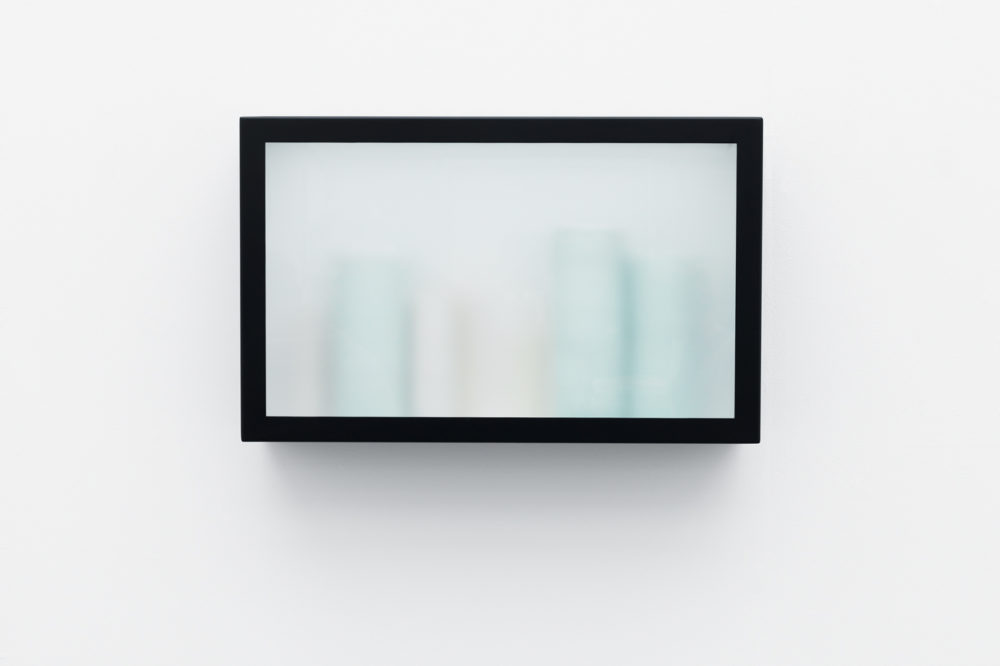
A selection of works by Edmund de Waal from the V&A collection are included in this exhibition which explores the museum's collecting and exhibiting of studio pottery from the movement's beginnings to the present day.
A selection of works by Edmund de Waal from the V&A collection are included in this exhibition which explores the museum's collecting and exhibiting of studio pottery from the movement's beginnings to the present day.
Installation photography: © Victoria and Albert Museum

Edmund de Waal's 2016 piece, things exactly as they are, was on view in Tokyo's Panasonic Shiodome Museum of Art as part of the exhibition Picturesque Pottery. The exhibition celebrated modern and contemporary ceramics, bringing together works by artists including Bernard Leach, Kenkichi Tomimoto, Lucio Fontana, Isamu Noguchi, Lucie Rie and Axel Salto.
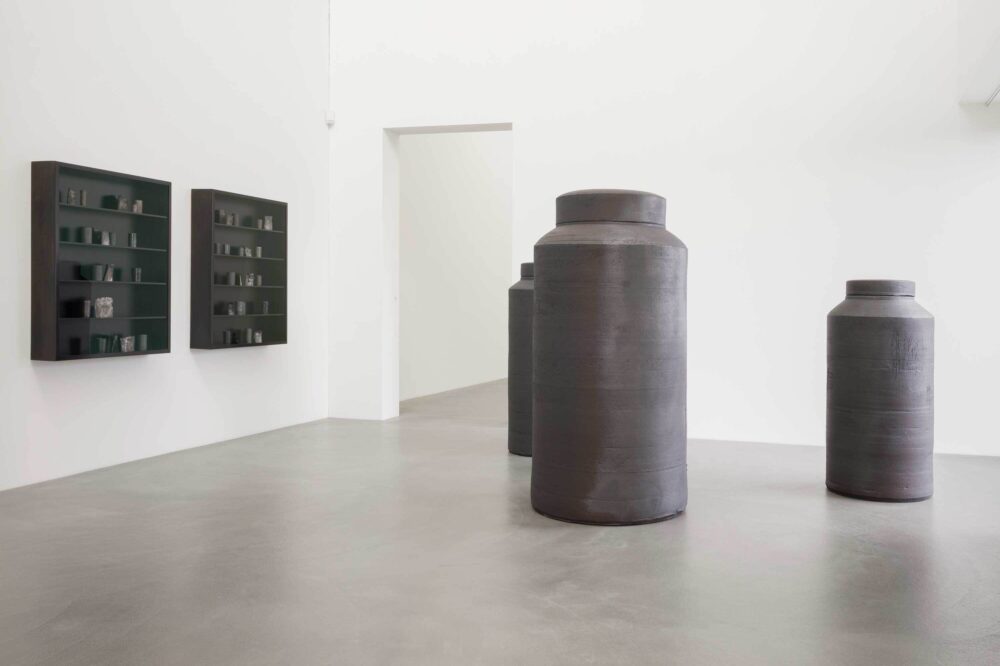
Edmund de Waal was part of an international group exhibition at Kunstmuseum Appenzell, Switzerland, exploring the role of ceramics in contemporary art. The exhibition included works from his 2023 series elegie; the largest vessels he has ever made.
Edmund de Waal was part of an international group exhibition at Kunstmuseum Appenzell, Switzerland, exploring the role of ceramics in contemporary art. The exhibition included works from his 2023 series elegie; the largest vessels he has ever made.
Curated by Stefanie Gschwend and Felicity Lunn, the show brought together artists for whom ceramics is central to their practice, investigating the sculptural potential of the medium and its relationship to painting, sculpture and craft.
Photography: Exhibition view, Sound of the Earth. Ceramic in Contemporary Art, 25.5.-14.9.2025, Kunstmuseum Appenzell, photo: Sebastien Verdon

The Royal Academy of Arts' annual Summer Exhibition this year included Edmund de Waal's 2025 piece, so much depends.
The Royal Academy of Arts' annual Summer Exhibition this year included Edmund de Waal's 2025 piece, so much depends.
Photography: Alzbeta Jaresova

Galerie Max Hetzler presented Potential Colour, a group exhibition in their gallery at 41 Dover Street London. Edmund de Waal's 2023 piece a house full of music, II, featured in the exhibition alongside works by Darren Almond, Glenn Brown, André Butzer, Günther Förg, Hans Josephsohn, KAWS, Albert Oehlen, Rebecca Warren and Grace Weaver.
Galerie Max Hetzler presented Potential Colour, a group exhibition in their gallery at 41 Dover Street London. Edmund de Waal's 2023 piece a house full of music, II, featured in the exhibition alongside works by Darren Almond, Glenn Brown, André Butzer, Günther Förg, Hans Josephsohn, KAWS, Albert Oehlen, Rebecca Warren and Grace Weaver.
Photography: Lucy Dawkins

Edmund de Waal's piece untitled (all, as a rule, fall towards their wound), 2024, was on display in Paris at Galerie Max Hetzler as part of their summer exhibition.
Edmund de Waal's piece untitled (all, as a rule, fall towards their wound), 2024, was on display in Paris at Galerie Max Hetzler as part of their summer exhibition.
Photography: Alzbeta Jaresova

untitled (brightness falls from the air), 2024, was on view at Galerie Max Hetzler's Window Gallery at Goethestraße 2/3, Berlin.
untitled (brightness falls from the air), 2024, was on view at Galerie Max Hetzler's Window Gallery at Goethestraße 2/3, Berlin.
Photography: def image

As part of a collaboration between Kunstmuseum Basel and Literaturhaus Basel, Edmund de Waal read from his work and reflected on the culture of remembrance. The event was moderated by Daniel Kurjakovic and Tessa Rosebrock of the Kunstmuseum Basel.
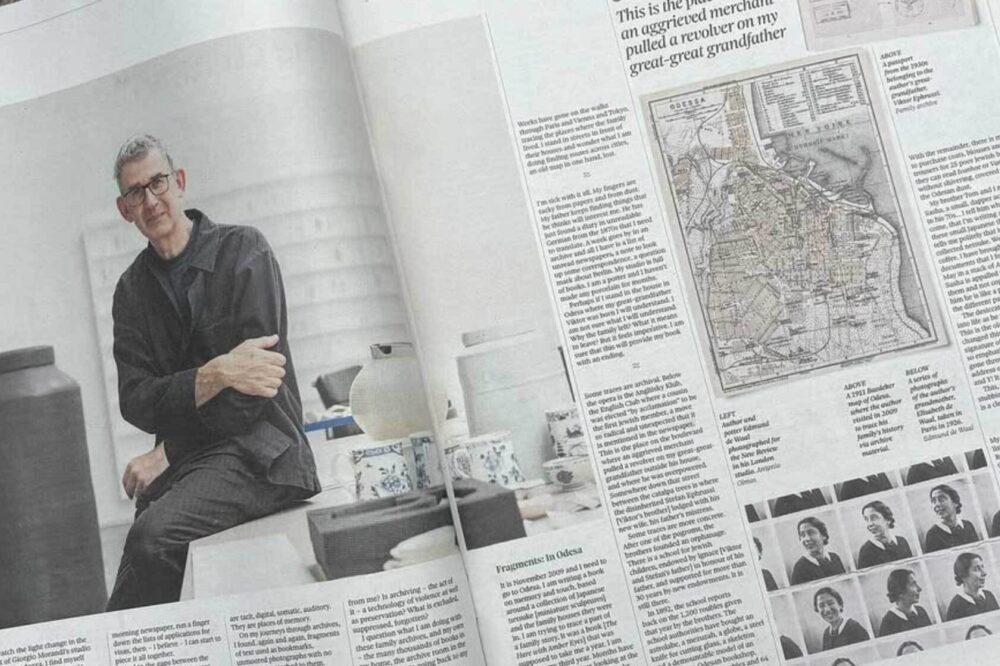
In this recent Observer piece, drawn from his new book An Archive, Edmund de Waal reflects on dust as a marker of time and memory, exploring its presence in places, objects and personal histories.

To celebrate the release of an Archive (Ivorypress, June 2025), Edmund de Waal joined Elena Foster and Bill Sherman for a conversation exploring the nature of archives; how they preserve, distort, and transmit memory.
To celebrate the release of an Archive (Ivorypress, June 2025), Edmund de Waal joined Elena Foster and Bill Sherman for a conversation exploring the nature of archives; how they preserve, distort, and transmit memory.
The event reflected on the personal and institutional legacies held within archives, and their role in shaping future histories.

Edmund de Waal explored the theme of Create and Transform through fragments and brokenness. Bookended by musical performance, de Waal reflected on the creative power of pot shards, poetry, and the beauty of incompleteness in his work.
Edmund de Waal explored the theme of Create and Transform through fragments and brokenness. Bookended by musical performance, de Waal reflected on the creative power of pot shards, poetry, and the beauty of incompleteness in his work.
He examined how broken fragments spark transformation, shaping museum spaces and personal meaning. The event concluded with performances that respond to the theme, filling the Ashmolean with soundscapes of creation, transformation, and cultural resonance.
Photography: Alzbeta Jaresova

Place, at Roche Court Sculpture Park at the New Art Centre, Wiltshire, centred around four new works by Edmund de Waal; this place, which are a series of Kilkenny stone benches, and two other installations titled landfall and particular things.
Place, at Roche Court Sculpture Park at the New Art Centre, Wiltshire, centred around four new works by Edmund de Waal; this place, which are a series of Kilkenny stone benches, and two other installations titled landfall and particular things.
Made from fossil-studded Irish stone with traces of silver, the benches embody the heritage and geology of our islands. Surrounding them were Ian Stephenson’s cosmic paintings, evoking the rhythms of the sky, John Hubbard’s dramatic landscapes, and Hubert Dalwood’s shining, space-age sculptures.
Photography: New Art Cetnre

In this special event, cook and food writer Nigel Slater and Edmund de Waal explored how art, cooking and everyday beauty intertwine; and how finding small moments of joy feels like a radical and necessary act in today’s society.
In this special event, cook and food writer Nigel Slater and Edmund de Waal explored how art, cooking and everyday beauty intertwine; and how finding small moments of joy feels like a radical and necessary act in today’s society.
Photograph: Charleston Farmhouse by Simon Carey, CC BY-SA 2.0, via Wikimedia Commons

Edmund de Waal was in conversation with biographer Hermione Lee about his life and work, as well as the intersections of art and memoir-writing. The event was followed by a complimentary wine reception and book sale.
Edmund de Waal was in conversation with biographer Hermione Lee about his life and work, as well as the intersections of art and memoir-writing. The event was followed by a complimentary wine reception and book sale.
Photo: Ben McKee
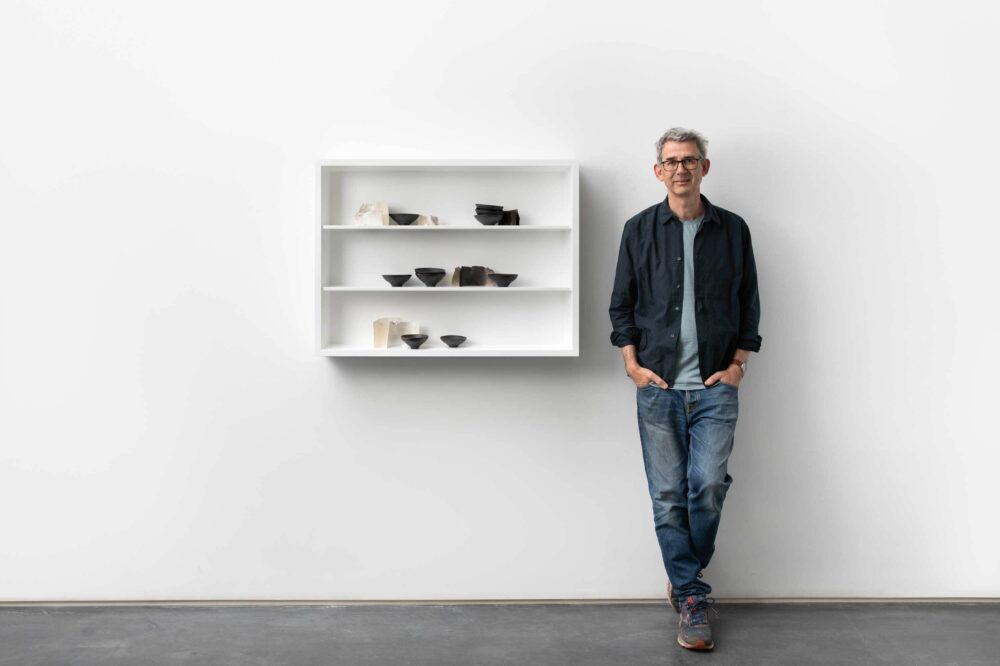
Edmund de Waal led a digital celebration of Virginia Woolf’s Mrs Dalloway as part of the Hay Festival Book Club. In this 60-minute online event, de Waal shared his insights into Woolf’s timeless novel, diving into his personal reading and interpretations.
Edmund de Waal led a digital celebration of Virginia Woolf’s Mrs Dalloway as part of the Hay Festival Book Club. In this 60-minute online event, de Waal shared his insights into Woolf’s timeless novel, diving into his personal reading and interpretations.
The session included 45 minutes of chaired discussion, followed by 15 minutes for audience questions, which were curated and filtered in advance.
Photography: Alzbeta Jaresova

100 years to the day from publication, Caleb Azumah Nelson, Edmund de Waal and Deborah Levy took Virginia Woolf's Mrs Dalloway as the inspiration for three new pieces of work, while Chineke! Chamber Orchestra performed Florence B. Price’s ‘String Quartet No. 1 in G Major’ and movements from Max Richter’s ‘Woolf Works’, accompanied by readings from the novel.
100 years to the day from publication, Caleb Azumah Nelson, Edmund de Waal and Deborah Levy took Virginia Woolf's Mrs Dalloway as the inspiration for three new pieces of work, while Chineke! Chamber Orchestra performed Florence B. Price’s ‘String Quartet No. 1 in G Major’ and movements from Max Richter’s ‘Woolf Works’, accompanied by readings from the novel.
Photograph: Public domain, via Wikimedia Commons

BBC's Front Row marked the centenary of Virginia Woolf’s Mrs Dalloway. The episode featured a conversation between novelist Elif Shafak, Professor Rachel Bowlby and Edmund de Waal, celebrating the novel's lasting influence and its insightful reflections on time, memory, and the creative process.
BBC's Front Row marked the centenary of Virginia Woolf’s Mrs Dalloway. The episode featured a conversation between novelist Elif Shafak, Professor Rachel Bowlby and Edmund de Waal, celebrating the novel's lasting influence and its insightful reflections on time, memory, and the creative process.
Photo: Tom Jamieson

Edmund de Waal is one of 25 artists, designers, and architects commissioned by Loewe for Milan Design Week 2025 to create a teapot, now on view at Palazzo Citterio alongside a curated selection of exclusive homewares produced by Loewe for Salone.
Edmund de Waal is one of 25 artists, designers, and architects commissioned by Loewe for Milan Design Week 2025 to create a teapot, now on view at Palazzo Citterio alongside a curated selection of exclusive homewares produced by Loewe for Salone.
Studio photography: Alzbeta Jaresova

Edmund de Waal joined Laura Beatty, the Ondaatje Prize-shortlisted novelist and biographer, in this special event to celebrate the publication of her chapbook Pear Trees. Beatty read from the chapbook and was in conversation de Waal.
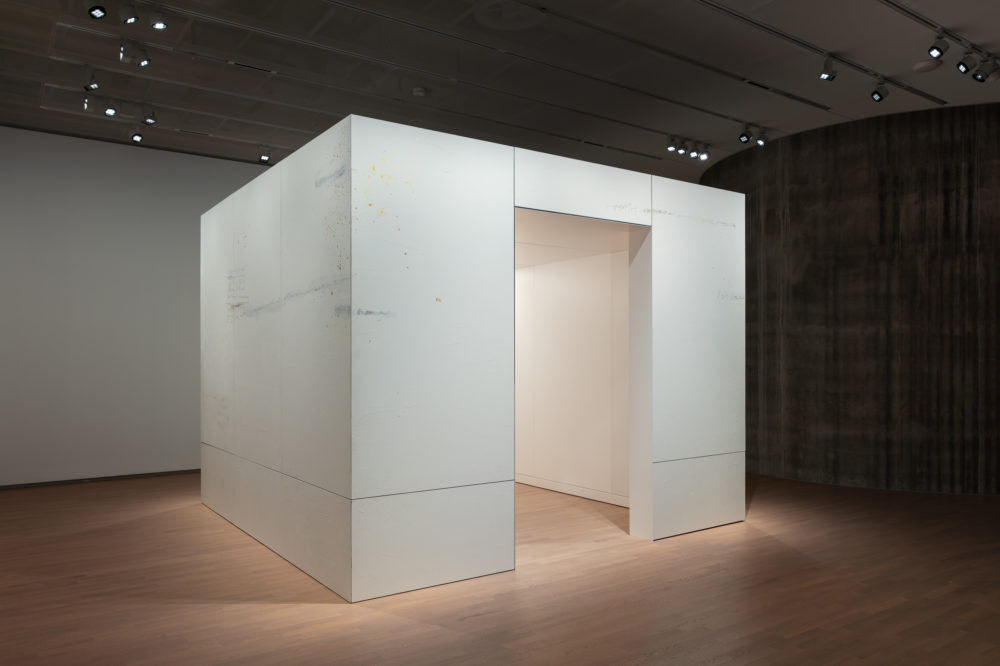
Playing with Fire, a collaboration between Edmund de Waal, CLAY Museum of Ceramic Art Denmark and Kunstsilo in Norway, was on view at the Kunstsilo before its final stop at The Hepworth Wakefield, West Yorkshire, in 2025.
Playing with Fire, a collaboration between Edmund de Waal, CLAY Museum of Ceramic Art Denmark and Kunstsilo in Norway, was on view at the Kunstsilo before its final stop at The Hepworth Wakefield, West Yorkshire, in 2025.
This exhibition brought together a significant number of Salto’s ceramic works from the CLAY Museum and The Tangen Collection at Kunstsilo, the world’s largest collection of Nordic modernist art. Salto’s ceramics were shown alongside his lesser-known and unseen works on paper, illustrations, writings and textiles, and a major new installation by de Waal which reflects on Salto’s enduring influence.
“Axel Salto is one of the greatest artists of the twentieth century. He created a unique body of ceramic work that continues to fascinate me. His sculptures seem to be on the point of change: glazes are caught in flux. Vases swell as if to burst. He cared about the ways that patterns change course, shift energies, how an animal becomes a person, a man metamorphoses into a stag. Ovid ran powerfully through his life. That moment of change, transformation, is the moment when poetry occurs.”
- Edmund de Waal
Photography: Tor Simen Ulstein

Edmund de Waal was joined in conversation with Josh Spero of the Finanical Times at this TEFAF Salon event. Their conversation explored the key influences on de Waal’s work, such as history, personal heritage, and poetry.
Edmund de Waal was joined in conversation with Josh Spero of the Finanical Times at this TEFAF Salon event. Their conversation explored the key influences on de Waal’s work, such as history, personal heritage, and poetry.
It also touched upon his deep connection to art and craft, emphasising his advocacy for experiencing art across different eras and geographies. Click the icon below to watch.
Photography: Ben McKee

This screening of Ruth Zylberman's film investigating the legacy of the Camondo family was followed by a conversation between the filmmaker and Edmund de Waal, whose book Letters to Camondo was published in 2021, alongside an exhibition of installations at the Musée Nissim de Camondo, Paris.

For the Chester Beatty Annual Lecture this year, Edmund de Waal presented Good for a Single Journey: Netsuke and Stories in a Fractured World.
For the Chester Beatty Annual Lecture this year, Edmund de Waal presented Good for a Single Journey: Netsuke and Stories in a Fractured World.
In this illustrated lecture he recounted the story of discovering his great uncle's collection of netsuke and how this unexpected inheritance led him to explore ideas of exile and migration in both his writing and his artistic practice. Click the icon below to watch.
Photography: Tom Jamieson

Hosted by The Brooklyn Rail, this event brought together curator Dr. Alice Ensabella, artists Tacita Dean, Edmund de Waal, Joel Meyerowitz, and Luc Tuymans, alongside Brooklyn Rail's ArtSeen editor Amanda Gluibizzi, for a discussion on Giorgio Morandi's life, work, and legacy.
Hosted by The Brooklyn Rail, this event brought together curator Dr. Alice Ensabella, artists Tacita Dean, Edmund de Waal, Joel Meyerowitz, and Luc Tuymans, alongside Brooklyn Rail's ArtSeen editor Amanda Gluibizzi, for a discussion on Giorgio Morandi's life, work, and legacy.
The conversation complemented the current exhibition at David Zwirner in New York. Click the icon below to watch a recording of the talk.
Photography: Tom Jamieson

To mark the completion of the Warburg Renaissance project and the opening of the Institute’s new gallery space, Memory & Migration presented a selection of objects from the collection that explored its interwoven histories of movement and survival. Included in the exhibition was Edmund de Waal's library of exile, which has been donated to the institute.

Several new works, including the tsukubai illustrated here, wind, water, stone, were recently on view at the New Art Centre at Roche Court, Wiltshire.

At Ordovas, London, is Golds, was an exhibition exploring one of the most symbolic colours in the history of art, and how it has been used and represented in the work of significant artists from the twentieth and twenty-first centuries. De Waal's 2022 piece, K. 314, was a part of the show.
At Ordovas, London, is Golds, was an exhibition exploring one of the most symbolic colours in the history of art, and how it has been used and represented in the work of significant artists from the twentieth and twenty-first centuries. De Waal's 2022 piece, K. 314, was a part of the show.
Installation photography: Stuart Burford

De Waal's 2023 piece Letters to Amherst, II, was on view at the Georgia Museum of Art as part of their exhibition highlighting recent acquisitions to the permanent collection.
De Waal's 2023 piece Letters to Amherst, II, was on view at the Georgia Museum of Art as part of their exhibition highlighting recent acquisitions to the permanent collection.
Photography: Alzbeta Jaresova

The Shape of Things, at Pallant House Gallery, questioned the idea that still life is a lesser genre, showing how important it is to artists and society.
The Shape of Things, at Pallant House Gallery, questioned the idea that still life is a lesser genre, showing how important it is to artists and society.
De Waal's 2021 piece September Song, II, was on display alongside works by Hurvin Anderson, Vanessa Bell, Edward Burra, Patrick Caulfield, Lucian Freud, Gluck, Duncan Grant, Richard Hamilton, Mona Hatoum, Jann Haworth, David Hockney, Lee Miller, Paul Nash, Ben Nicholson, William Nicholson, Eric Ravilious, Anwar Jalal Shemza, William Scott, Walter Sickert, Stanley Spencer, Rachel Whiteread and Clare Woods. The exhibition looked at how these artists have used traditional art history to express the complexities of the human condition.

On this episode of BBC Radio 4's cultural programme, Front Row, Edmund de Waal discusses the 2024 Booker Prize shortlist. Click the icon below to listen.

This exhibition included both the largest free-standing clay vessels that Edmund de Waal has ever created, and a large-scale pavilion titled there are still songs to sing beyond mankind, 2024.
This exhibition included both the largest free-standing clay vessels that Edmund de Waal has ever created, and a large-scale pavilion titled there are still songs to sing beyond mankind, 2024.
Photography: def image

5&20, an exhibition co-curated by Brookfield Properties and Crafts Council was on view in the foyer of 99 Bishopsgate. Edmund de Waal's 2007 piece, Arcady, was included in the exhibition alongside other works from Crafts Council Collection.

Fragments of Memory. The Treasury of St Vitus Cathedral in Prague in Dialogue with Edmund de Waal, Josef Koudelka and Julian Rosefeld was on show at Kunsthalle im Lipsiusbau, Dresden. The exhibition included de Waal's 2016 large-scale installation irrkunst.
Fragments of Memory. The Treasury of St Vitus Cathedral in Prague in Dialogue with Edmund de Waal, Josef Koudelka and Julian Rosefeld was on show at Kunsthalle im Lipsiusbau, Dresden. The exhibition included de Waal's 2016 large-scale installation irrkunst.
Photography: Martin Polák

Edmund de Waal created a poster celebrating Handel's Giulio Cesare as part of Glyndebourne's 90th anniversary celebrations, which was presented in the exhibition From Then to Now: 90 Years of Glyndebourne Posters.
Edmund de Waal created a poster celebrating Handel's Giulio Cesare as part of Glyndebourne's 90th anniversary celebrations, which was presented in the exhibition From Then to Now: 90 Years of Glyndebourne Posters.
The exhibition brought together newly commissioned posters responding to their 2024 Festival, alongside rarely seen posters from their archive.
Commissioned artists included Amy Beager, Rana Begum, Pablo Bronstein, Morag Caister, Michael Craig-Martin, Antony Gormley, Maggi Hambling, Chris Ofili, Vicken Parsons, Fiona Rae, and Conrad Shawcross. Each artist selected one production from Glyndebourne’s Festival 2024 repertoire to promote.
Photography: Alzbeta Jaresova

Edmund de Waal chaired the 2024 Booker Prize judging panel, joined by award-winning novelist Sara Collins; Fiction Editor of the Guardian, Justine Jordan; world-renowned writer and professor Yiyun Li; and musician, composer and producer Nitin Sawhney.
Edmund de Waal chaired the 2024 Booker Prize judging panel, joined by award-winning novelist Sara Collins; Fiction Editor of the Guardian, Justine Jordan; world-renowned writer and professor Yiyun Li; and musician, composer and producer Nitin Sawhney.
Orbital by Samantha Harvey was named the winner of the Booker Prize 2024. The winner was announced by Edmund de Waal at a ceremony held at Old Billingsgate in London.

In this illustrated lecture, Edmund de Waal explored his relationship with the idea of home through his writings and artistic practice. The lecture included discussion of his projects in Venice and at the Musée Camondo, Paris; Kunsthistorisches Museum, Vienna; Japanisches Palais, Dresden; and in Berlin.
In this illustrated lecture, Edmund de Waal explored his relationship with the idea of home through his writings and artistic practice. The lecture included discussion of his projects in Venice and at the Musée Camondo, Paris; Kunsthistorisches Museum, Vienna; Japanisches Palais, Dresden; and in Berlin.
Photography: Tom Jamieson

In conjunction with his exhibition letters home, Edmund de Waal gave a talk at Galerie Max Hetzler, Potsdamer Straße 77-87, in Berlin, on Saturday, 15 June.
In conjunction with his exhibition letters home, Edmund de Waal gave a talk at Galerie Max Hetzler, Potsdamer Straße 77-87, in Berlin, on Saturday, 15 June.
Taking place in the exhibition space, de Waal discussed his writings and artistic practice for this special event, touching on notions of home, memory and identity.
Photography: Ben McKee

Edmund de Waal curated an exhibition of acclaimed Danish ceramicist, Axel Salto (1889–1961), considered one of the greatest masters of twentieth-century ceramic art.
Edmund de Waal curated an exhibition of acclaimed Danish ceramicist, Axel Salto (1889–1961), considered one of the greatest masters of twentieth-century ceramic art.
The exhibition was the result of a collaboration between Edmund de Waal, CLAY Museum of Ceramic Art Denmark and Kunstsilo in Norway. Starting at CLAY in Middelfart, Denmark, it will tour to the Kunstsilo in September 2024 before its final stop at The Hepworth Wakefield, West Yorkshire, in 2025.
This exhibition brought together a significant number of Salto’s ceramic works from the CLAY Museum and The Tangen Collection at Kunstsilo, the world’s largest collection of Nordic modernist art. Salto’s ceramics were shown alongside his lesser-known and unseen works on paper, illustrations, writings and textiles, and a major new installation by de Waal which reflects on Salto’s enduring influence.
“Axel Salto is one of the greatest artists of the twentieth century. He created a unique body of ceramic work that continues to fascinate me. His sculptures seem to be on the point of change: glazes are caught in flux. Vases swell as if to burst. He cared about the ways that patterns change course, shift energies, how an animal becomes a person, a man metamorphoses into a stag. Ovid ran powerfully through his life. That moment of change, transformation, is the moment when poetry occurs.”
- Edmund de Waal
Photography: Ole Akhøj

Part of the European Capitals of Culture programme, All About The Vessel explored the development of ceramic art from early modernism to the present.
Part of the European Capitals of Culture programme, All About The Vessel explored the development of ceramic art from early modernism to the present.
Edmund de Waal's 2016 piece, once is as good as never, was exhibited alongside works by Lucie Rie, Betty Woodman, Sterling Ruby, Masaomi Yasunaga and Lindsey Mendick

Works by Edmund de Waal joined those by Barbara Hepworth, John Hubbard and Ian Stephenson in this exhibition at the New Art Centre at Roche Court Sculpture Park, Salisbury.
Works by Edmund de Waal joined those by Barbara Hepworth, John Hubbard and Ian Stephenson in this exhibition at the New Art Centre at Roche Court Sculpture Park, Salisbury.
Photo: courtesy of the New Art Centre

stèles, I (2022) was recently on view at 8smicka, an art foundation in the Czech Republic, as part of an exhibition titled IN MARGINE. The show brought together numerous artists, past and present, who have reconceptualized the framework for art display.
stèles, I (2022) was recently on view at 8smicka, an art foundation in the Czech Republic, as part of an exhibition titled IN MARGINE. The show brought together numerous artists, past and present, who have reconceptualized the framework for art display.
From plinth and vitrine to the frame itself, the exhibition considered how artists have brought these elements into the whole artwork in new and surprising ways since the nineteenth century. Until 19 May 2024.
Photo: Alzbeta Jaresova

Edmund de Waal was in conversation with Olivier Gabet, director of the Département des objets d’art at the Musée du Louvre, and curator of de Waal’s exhibition Lettres à Camondo at the Musée Nissim de Camondo in 2021. Click the icon below to watch.
Edmund de Waal was in conversation with Olivier Gabet, director of the Département des objets d’art at the Musée du Louvre, and curator of de Waal’s exhibition Lettres à Camondo at the Musée Nissim de Camondo in 2021. Click the icon below to watch.
Photo: Christophe Dellière. © MAD, Paris. Courtesy of the artist and of Musée des Arts Décoratifs, Paris.

In this major retrospective of the work of Rudolf Levy, co-organised by the MPK and the Uffizi, Levy's last self-portrait was juxtaposed with Edmund de Waal's 2016 piece, Spur.

In this special event at Vienna's Konzerthaus, Edmund de Waal read from his book Letters to Camondo, accompanied by the Javus Quartett.

this must be the place, a major exhibition of de Waal's vitrines and stone benches, was installed at Gagosian's West 24th Street space.
this must be the place, a major exhibition of de Waal's vitrines and stone benches, was installed at Gagosian's West 24th Street space.
De Waal relates: “For the last two years my studio has been full of silver, steel, marble, and porcelain. This new body of work is about place—where things come from, where they belong, what we remember and pass on. The materials echo places. I use porcelain clay from Limoges but turn it black with oxides and inscribe it with remembered poetry. I use marble from Kilkenny and push folded sheets of silver into crevices like prayers into a wall. The work is full of fragments, scraps of silver on the rims of bowls, poems, music, echoes of people that matter to me and the places where they lived. These sculptures are new places.”
this must be the place was complemented by the presentation of to light, and then return— at Gagosian’s gallery at 976 Madison Avenue, New York, from September 14 to October 28, 2023. This exhibition featured sculptures by de Waal and platinum prints and tintypes by Sally Mann that each artist created in response to the other’s work.
Photography: Alzbeta Jaresova

An exhibition of new works by Edmund de Waal and Sally Mann, inspired by each other’s practices, was installed Gagosian's Madison Avenue space. to light, and then return— marked the first time the two artists have shown together in a dedicated exhibition.
An exhibition of new works by Edmund de Waal and Sally Mann, inspired by each other’s practices, was installed Gagosian's Madison Avenue space. to light, and then return— marked the first time the two artists have shown together in a dedicated exhibition.
The result of an ongoing exchange between two artists, who are also celebrated writers, the exhibition was titled after the final line of The spry arms of the wind (c. 1866), a poem written by Emily Dickinson on an envelope scrap. Informed by their mutual fascination with material transformation and themes of elegy and historical reckoning, the works on view included de Waal’s sculptural installations featuring porcelain and other materials, and Mann’s tintypes and platinum prints.
to light, and then return— was complemented by this must be the place, an exhibition of new works by de Waal at 541 West 24th Street, New York, from 13 September until 28 October 2023.
Photography:
De Waal's work: Alzbeta Jaresova
Mann's work: © Sally Mann, Photo: Rob McKeever, Courtesy Gagosian

In October's issue of The Brooklyn Rail, Edmund de Waal and Phong H. Bui are in conversation and discussing poetry, repetition, scale, still life, and the making of the exhibition this must be the place at Gagosian, New York.

On this episode, of Time Sensitive from The Slowdown, Edmund de Waal talks with Spencer Bailey about his infatuation with Japan, his affinity for the life and work of the Japanese-American artist Isamu Noguchi, and the roles of rhythm and breath in his work.
On this episode, of Time Sensitive from The Slowdown, Edmund de Waal talks with Spencer Bailey about his infatuation with Japan, his affinity for the life and work of the Japanese-American artist Isamu Noguchi, and the roles of rhythm and breath in his work.
Image: courtesy of Time Sensitive podcast
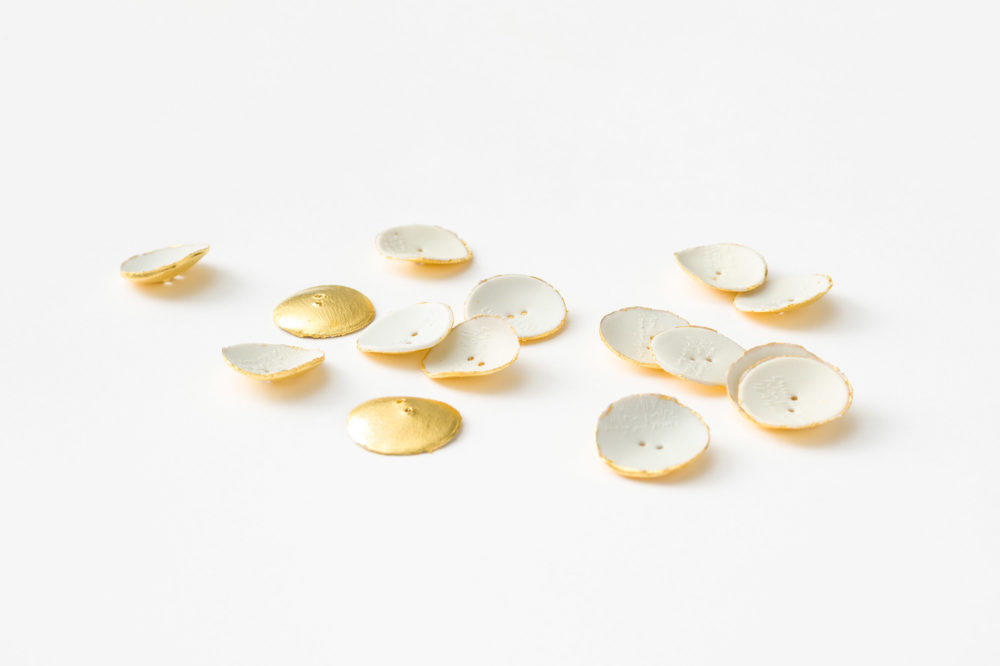
In support of Kettle's Yard, Cambridge, Edmund de Waal, along with Ai Weiwei, Jonathan Anderson, Rana Begum, Antony Gormley, Callum Innes, Jennifer Lee, Cornelia Parker, Vicken Parsons and Caroline Walker, have created a limited edition sets of buttons.
In support of Kettle's Yard, Cambridge, Edmund de Waal, along with Ai Weiwei, Jonathan Anderson, Rana Begum, Antony Gormley, Callum Innes, Jennifer Lee, Cornelia Parker, Vicken Parsons and Caroline Walker, have created a limited edition sets of buttons.
The project draws inspiration from the exhibition, Lucie Rie: The Adventure of Pottery, recently at Kettle’s Yard and now on view until January 2024 at the Holburne Museum in Bath. In 1938, Lucie Rie fled her home in Vienna for London to escape the Nazi persecution of Jewish people. During the war, unable to get a licence to make pots, Rie turned to making ceramic buttons for the fashion industry, experimenting on a miniature scale with new forms and coloured glazes.

In conjunction with the exhibition Lucie Rie: The Adventure of Pottery, Edmund de Waal gave a talk about Rie’s life in both Vienna and London, and her influence on his own work.

Edmund de Waal delivered the fourth City of Literature lecture as part of UNESCO's City of Literature programme.
Edmund de Waal delivered the fourth City of Literature lecture as part of UNESCO's City of Literature programme.
Photo: Ben McKee

Edmund de Waal has been awarded the Isamu Noguchi Award for his contribution as both a writer and artist.
Edmund de Waal has been awarded the Isamu Noguchi Award for his contribution as both a writer and artist.
Established in 2014 and presented annually, the award perpetuates Noguchi’s legacy by acknowledging highly accomplished individuals who share his spirit of innovation, unbounded imagination, and uncompromising commitment to creativity. Honouring those whose work exhibits qualities of artistic excellence, the award also recognises work that carries significant social consciousness and function. De Waal received the award during the annual benefit gala at the Noguchi Museum, New York, on September 2023, along with artist, Theaster Gates, and novelist and editor Hanya Yanagihara.
Photo: Eva Deitch. © INFGM / ARS
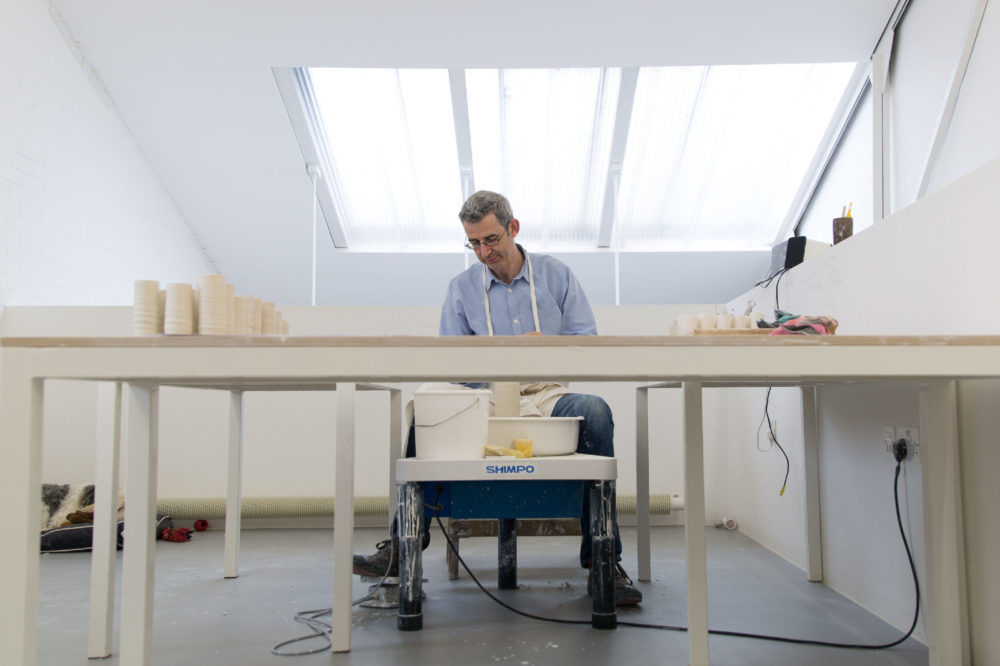
For BBC Radio 4's This Cultural Life, Edmund de Waal discussed with John Wilson the formative influences and inspirations behind his practice. Click the icon below to listen.
For BBC Radio 4's This Cultural Life, Edmund de Waal discussed with John Wilson the formative influences and inspirations behind his practice. Click the icon below to listen.
Photograph: Ben McKee
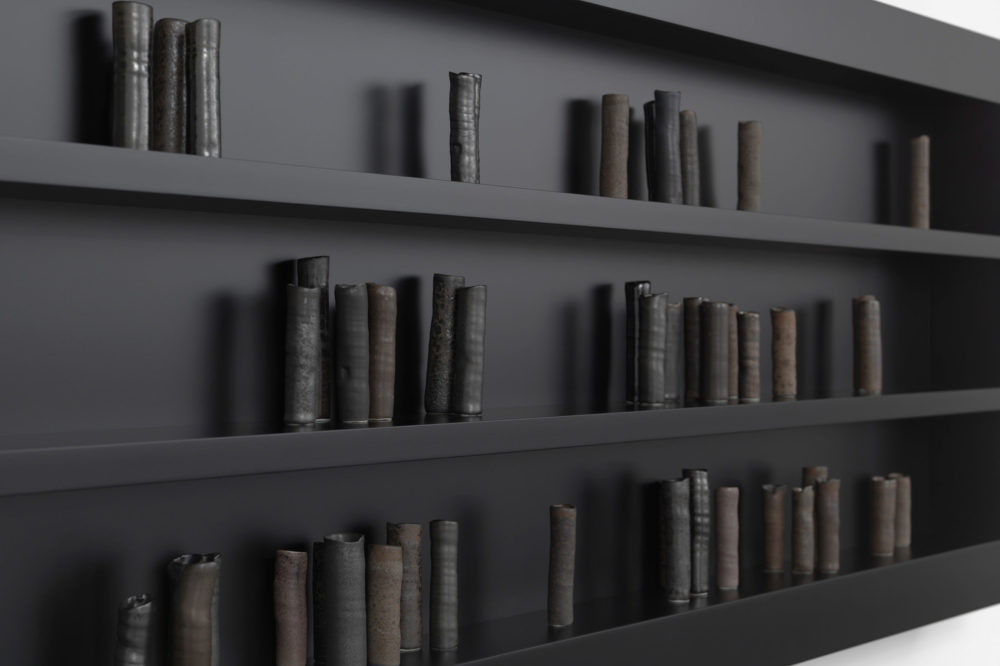
De Waal's 2015 piece, to begin again, was part of an exhibition on contemporary ceramics at Des Moines Art Center, Iowa.
De Waal's 2015 piece, to begin again, was part of an exhibition on contemporary ceramics at Des Moines Art Center, Iowa.
This exhibition also featured artworks by Ai WeiWei, Katayoun Amjadi, Eliza Au, Sally Binard, Paul Briggs, Candice J. Davis, Theaster Gates, Donté K. Hayes, Simone Leigh, Ingrid Lilligren, Cannupa Hanska Luger, Anina Major, Heidi McKenzie, Magdalene A.N. Odundo, DBE, Vick Quezada, Ibrahim Said, Rae Stern, and Ehren Tool.
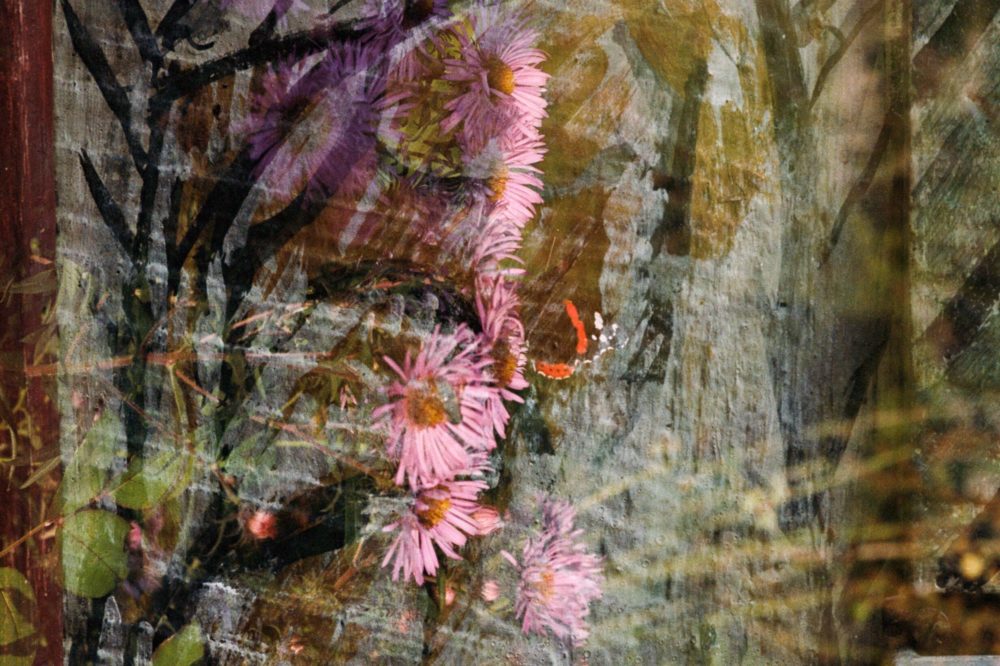
At the Charleston Festival of the Garden, Edmund de Waal was in conversation reflecting on the beauty and importance of decay
At the Charleston Festival of the Garden, Edmund de Waal was in conversation reflecting on the beauty and importance of decay
Every autumn, we witness decay on a grand scale as leaves fall and gardens die back for the winter, leaving only shapes and structures behind. But what value can be found in decay? In ‘Perdendosi’, his recent collaborative work with photographer Norman McBeath, de Waals’s text ‘Twelve Leaves’, sits alongside 12 photographs of leaves undergoing this transformation, becoming more like parchment than plant, taking up the most extraordinary shapes and revealing unique personalities. See decay with fresh eyes as we consider the beauty of the natural skeletons it leaves behind.
Photography: Lewis Ronald

In a new programme for BBC Radio 4, Edmund de Waal spoke to Dr Tristram Hunt, Director of the Victoria and Albert Museum, about the life of Josiah Wedgwood, his genius and his legacy. First broadcast in June the full programme is now available to listen again on BBC Sounds.
In a new programme for BBC Radio 4, Edmund de Waal spoke to Dr Tristram Hunt, Director of the Victoria and Albert Museum, about the life of Josiah Wedgwood, his genius and his legacy. First broadcast in June the full programme is now available to listen again on BBC Sounds.
Photograph: Tray of Queen's ware trials, by Josiah Wedgwood and sons, 1765, Stoke-on-Trent, England. Museum no. WE.4119-2014. © Victoria and Albert Museum, London

Edmund de Waal will be at this year's Borris House Festival of Writing and Ideas, in conversation with Dorothy Cross and Phillippe Sands.
Edmund de Waal will be at this year's Borris House Festival of Writing and Ideas, in conversation with Dorothy Cross and Phillippe Sands.
Photography: Tom Jamieson

In spring 2023, de Waal's installation, proem (2017), was on display at Arnolfini, Bristol, as part of ADORE - a major exhibition celebrating the work of photographer Garry Fabian Miller. Shown alongside Fabian Miller's inventive, 'camera-less' photographs, were the work of the artists, writers and thinkers who have inspired him over the years.

For this re-airing of BBC Radio 3's series The Essay, de Waal read five essays on migration, pots, and potters, including Magdalene Odundo, Hans Coper and Josiah Wedgwood. Listen to the entire series via the link below.

This exhibition, the first temporary exhibition in The Feuerle Collection Silk Room, focused on a selection of recent works by de Waal, juxtaposed with unseen pieces from the collection.
This exhibition, the first temporary exhibition in The Feuerle Collection Silk Room, focused on a selection of recent works by de Waal, juxtaposed with unseen pieces from the collection.
Photography: The Feurle Collection / De Waal Studio

In March, de Waal was invited to speak at MFA Boston as part of the Ruth and Carl Shapiro Lecture series. The talk focussed on his artistic process, storytelling and the poetry of sculpture.
In March, de Waal was invited to speak at MFA Boston as part of the Ruth and Carl Shapiro Lecture series. The talk focussed on his artistic process, storytelling and the poetry of sculpture.
Photography: Sintakso, CC BY-SA 4.0 <;, via Wikimedia Commons

Edmund de Waal joined Celia Paul for an evening hosted by Katy Hessel at Art/Lit, The London Library’s regular salon event.

On the White Road is a limited-edition series of four fine bone china plates designed by Edmund de Waal, created in collaboration with the V&A and Wedgwood. The design for each plate is inspired by a different object in the V&A and the V&A Wedgwood Collection, reflecting the breadth of the museum's vast collection and its relationship with the iconic Wedgwood.
On the White Road is a limited-edition series of four fine bone china plates designed by Edmund de Waal, created in collaboration with the V&A and Wedgwood. The design for each plate is inspired by a different object in the V&A and the V&A Wedgwood Collection, reflecting the breadth of the museum's vast collection and its relationship with the iconic Wedgwood.
Each of the works chosen by de Waal to inform his designs marks a key moment in the history of porcelain. Expertly produced by Wedgwood in Stoke-on-Trent, with only 150 editions made, each plate bears de Waal's printed signature a gold emblem depicting alongside the piece from the collection that inspired the design. These beautifully finished decorative pieces come packaged in a bespoke V&A and V&A Wedgewood gift box, including a signed and numbered certificate of authenticity featuring original text written by de Waal and further information on each of the referenced objects from the V&A and V&A Wedgwood Collection.
Photography: Carlos Jiminez

Perdendosi is a collaborative work by photographer Norman McBeath with Edmund de Waal. This publication which includes de Waal's text Twelve Leaves was published in September 2022.
Perdendosi is a collaborative work by photographer Norman McBeath with Edmund de Waal. This publication which includes de Waal's text Twelve Leaves was published in September 2022.
It is a study of leaves at the stage of their transformation when they have lost all colour, and become more like parchment than plant, taking up the most extraordinary shapes, giving the leaves unique identities and character. Many of the photographs were taken at the start of the pandemic in a time of daily news of increasing deaths and infections. Although not a direct response, this time had a profound influence on how Norman McBeath saw the leaves. Edmund de Waal’s accompanying text ‘Twelve Leaves’, which he describes as both autobiography and a journal of reading, is his own unique and moving response to living with these images for several months during lockdown. With a heightened awareness and increased sensitivity towards the natural world, Perdendosi offers a fresh perspective on the familiar.

Edmund de Waal took over the Gagosian Shop in London’s historic Burlington Arcade with de Waal +, which brought together recent artworks, treasured objects, and a selection of books curated by the artist.
Edmund de Waal took over the Gagosian Shop in London’s historic Burlington Arcade with de Waal +, which brought together recent artworks, treasured objects, and a selection of books curated by the artist.
“I’ve always wanted to take over a bookshop,” de Waal remarks. “I’ve filled it with books, of course. And music and photography, pamphlets recording projects created over the last decade, writing on artists I adore and poetry that sustains me, collaborations with dancers and composers, editions I have made for the British Art Medal Society and for the Victoria & Albert Museum. And I’ve added some pots that I have just made.”
In his interlinked sculptural, writing, and research practices, de Waal studies and utilizes objects as vehicles for human emotion and history. His installations of handmade porcelain vessels, often contained in minimalist structures, investigate themes of diaspora, memory, and materiality.
In addition to working across mediums, de Waal has also collaborated with museums, poets, performers, musicians, and other artists. Offering viewers a glimpse of his varied interests and inspirations, de Waal says, “I hope you come and find a corner to sit and read.”
The shop was open Tuesdays–Saturdays from 10am–6pm, no booking necessary.
Photography: Prudence Cuming Associates Ltd. Courtesy Gagosian.

Edmund de Waal, Anna Della Subin and Anthony Sattin in conversation with William Dalrymple at the Jaipur Literary Festival 2023.
Edmund de Waal, Anna Della Subin and Anthony Sattin in conversation with William Dalrymple at the Jaipur Literary Festival 2023.

Sensational Books explored our experiences of the book beyond reading. Held in the Bodleian's oldest reading room, the exhibition included de Waal's artist book, breath, published by Ivorypress in 2019.
Sensational Books explored our experiences of the book beyond reading. Held in the Bodleian's oldest reading room, the exhibition included de Waal's artist book, breath, published by Ivorypress in 2019.
breath is a book of poems by Paul Celan, both in German and in translation by Pierre Joris, printed on three different papers, washed with porcelain slip, rewritten and held together. The vellum-bound volume has fragments of medieval manuscript in its spine that had been used for other books before, a palimpsest - one reading overlapping with another.
Rub, stroke, chew, wear, sniff – Sensational Books structured around six senses of sight, sound, taste, smell, touch and proprioception, the sense of self-movement and body-perception, to unlock a world of sensory engagement with books.
Installation photos: Pablo Gómez-Ogando

Edmund de Waal joined Aanchal Malhotra in conversation at the Jaipur Literary Festival to discuss both The Hare with Amber Eyes and Letters to Camondo.

Strange Clay: Ceramics in Contemporary Art was the first large-scale group exhibition in the UK exploring how contemporary artists have used clay in unexpected ways. The exhibition included de Waal's installation atmosphere.
Strange Clay: Ceramics in Contemporary Art was the first large-scale group exhibition in the UK exploring how contemporary artists have used clay in unexpected ways. The exhibition included de Waal's installation atmosphere.
Photography: Mark Blower, Jemima Johnson

Edmund de Waal joined Andrew Logan and Ruth Ozeki in conversation with Kavita Puri on the subject of memoir at the Jaipur Literary Festival.

The Duke and Duchess of Devonshire present Living With Art We Love, an exhibition of a selection of favourite pieces from their collection.
The Duke and Duchess of Devonshire present Living With Art We Love, an exhibition of a selection of favourite pieces from their collection.
Contemporary artworks by Michael Craig Martin, Edmund de Waal, Natasha Daintry and Felicity Aylieff – artists actively collected and commissioned by the Duke and Duchess – are displayed alongside historic art from the Devonshire Collections rarely seen in public, including major works by Poussin, Rembrandt and Boltraffio.
Photography: Freddy Griffiths.

Magdalene Odundo and Edmund de Waal, both of whom appeared in Strange Clay: Ceramics in Contemporary Art, discuss clay’s intricacies as a medium.
Magdalene Odundo and Edmund de Waal, both of whom appeared in Strange Clay: Ceramics in Contemporary Art, discuss clay’s intricacies as a medium.
De Waal's 2014 installation, atmosphere, shown here installed at Turner Contemporary, Margate, was part of the exhibition.
Photography: Mike Bruce.
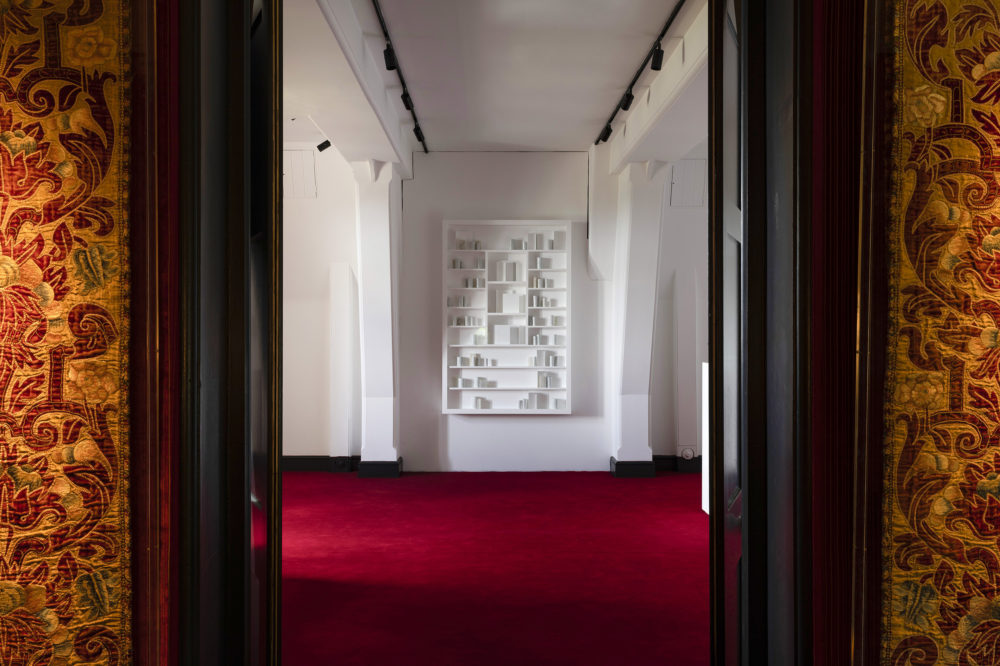
This exhibition brought together a curated selection of new and striking pieces. The installations explored the interconnected relations between faith, history, displacement, learning and archives – themes which feel more relevant than ever and which are woven into Waddesdon’s own fabric and existence.

Photographer Norman McBeath and de Waal was in conversation with Alexandra Harris, Professor of English at Birmingham University and author, discussing their collaboration on Perdendosi at the London Review Bookshop.

Join Edmund de Waal and V&A Director Tristram Hunt for a discussion of his inspirations and practice, and their shared love for ceramics, including an exploration of the remarkable connection between Josiah Wedgwood, porcelain, and the hunt for the great white clay.
Join Edmund de Waal and V&A Director Tristram Hunt for a discussion of his inspirations and practice, and their shared love for ceramics, including an exploration of the remarkable connection between Josiah Wedgwood, porcelain, and the hunt for the great white clay.
The talk is in celebration of de Waal’s collaboration with the V&A and Wedgwood: On the White Road, a limited-edition series bone china plates inspired by objects from the V&A and V&A Wedgwood Collection.
Photograph: Tom Jamieson

The Dutch National Ballet presents Shadows, a series of ballets about war, power and hope. Part of the programme will be the Dutch premier of Yugen, the ballet by Wayne McGregor for which de Waal designed the set in 2017.
The Dutch National Ballet presents Shadows, a series of ballets about war, power and hope. Part of the programme will be the Dutch premier of Yugen, the ballet by Wayne McGregor for which de Waal designed the set in 2017.
Photography: Andrej Uspenski
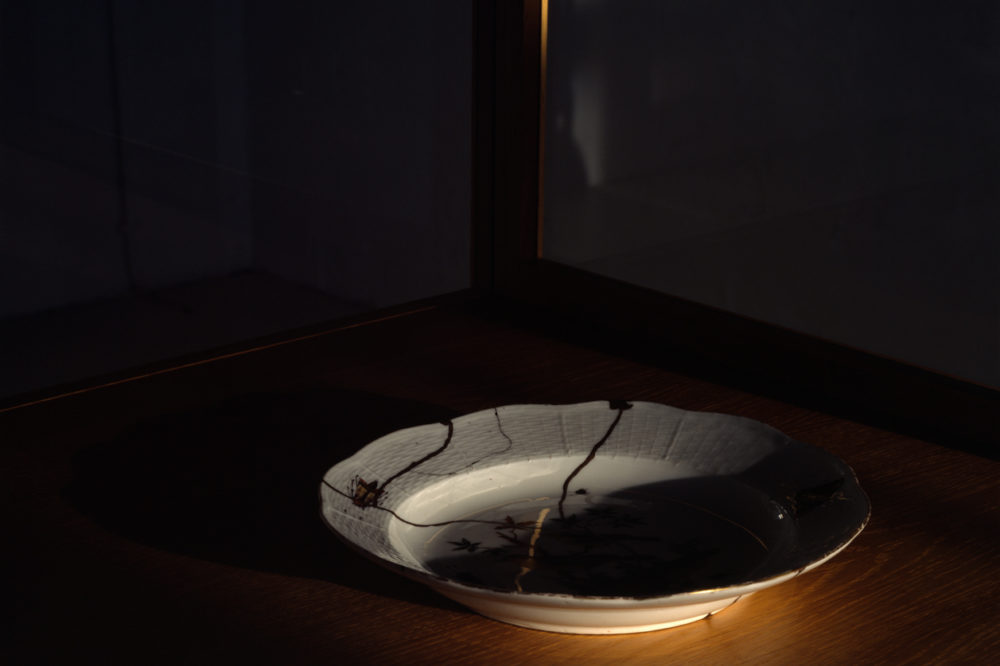
Three Meissen plates, with kintsugi repairs, which were first shown in the Dresden incarnation of the Library of Exile are currently on display as part of Eternally Yours, an exhibition at Somerset House, London, exploring ideas around care, repair and healing.

This group exhibition brings together works by Edmund de Waal, Käthe Kollwitz, Alice Neel, Cerith Wyn Evans and many more.
This group exhibition brings together works by Edmund de Waal, Käthe Kollwitz, Alice Neel, Cerith Wyn Evans and many more.
that other world, the world of the teapot, is the world the writer and the 2018 Nobel Prize in Literature Laureate Olga Tokarczuk is longing for. In her Nobel Lecture, the author recalls Hans Christian Andersen fairy tale of a teapot, broken by the people's awkwardness and their carelessness, and immediately disposed of and rejected.
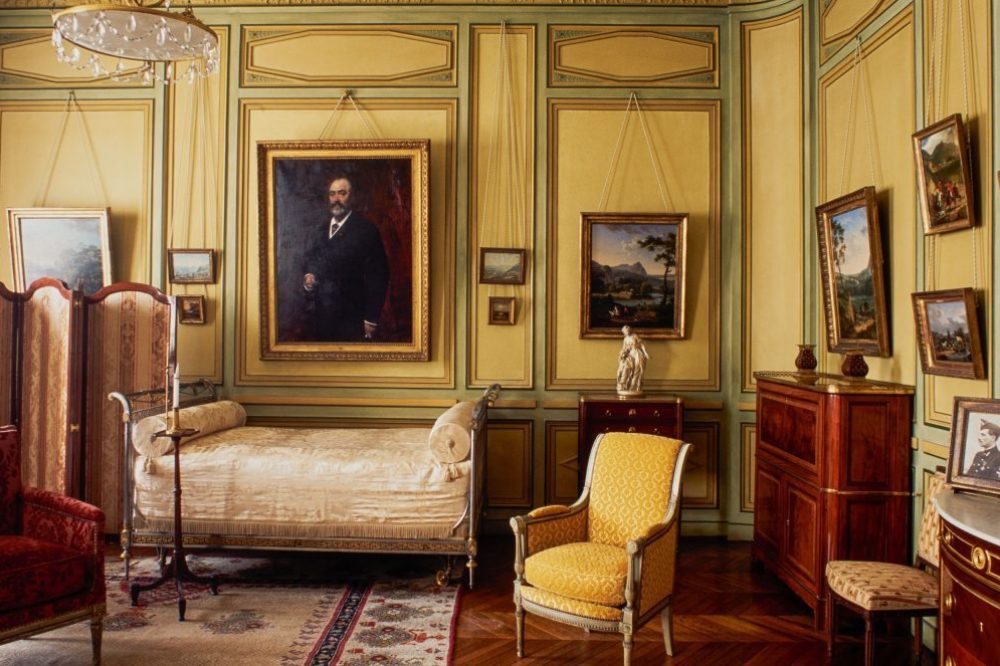
At Hatchards, Piccadilly, to celebrate the paperback publication of his book Letters to Camondo, de Waal discussed his exploration of the Camondos’ lavish rooms and detailed archives which led him to write this haunting series of letters to the Count, reflecting on the events that so scarred 20th-century Europe.
At Hatchards, Piccadilly, to celebrate the paperback publication of his book Letters to Camondo, de Waal discussed his exploration of the Camondos’ lavish rooms and detailed archives which led him to write this haunting series of letters to the Count, reflecting on the events that so scarred 20th-century Europe.
Photograph: Room of Nissim de Camondo. Paris, Musée Nissim de Camondo. © MAD, Paris / Jean-Marie del Moral

The paperback edition of Letters to Camondo was published on 2 June 2022 by Vintage Publishing. To celebrate the publication, there was a special feature exploring the book on bookshop.org. Please click below to find out more.

For two nights only, see Ballet des Porcelaines, a lost 18th-century ballet, performed in the fairy-tale grounds of Waddesdon before exploring the Manor and the new exhibition by Edmund de Waal after-hours.
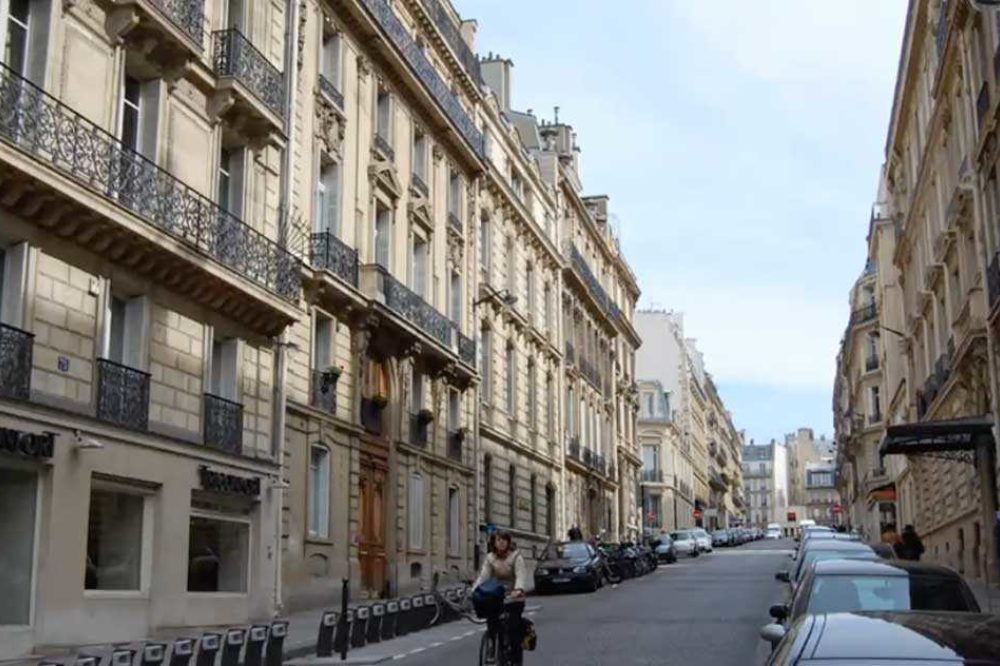
Edmund de Waal was in conversation with Chad Coerver, executive director of the Contemporary Jewish Museum, San Francisco for the Jewish Learning Works Marsha Rivkind Raleigh Memorial Lecture.
Edmund de Waal was in conversation with Chad Coerver, executive director of the Contemporary Jewish Museum, San Francisco for the Jewish Learning Works Marsha Rivkind Raleigh Memorial Lecture.
Photo: Slide from the lecture

At this year's Hay Festival, Edmund de Waal joined art historian, curator and broadcaster Katy Hessel to discuss Letters to Camondo. Click the link below for a recording via the Hay Player (subscription required).
At this year's Hay Festival, Edmund de Waal joined art historian, curator and broadcaster Katy Hessel to discuss Letters to Camondo. Click the link below for a recording via the Hay Player (subscription required).
Photo: Tom Jamieson

Memory and archives are the main concepts of this conversation. In it, Edmund de Waal and Hans Ulrich Obrist converse, highlighting their work as artists and writers in relation to the above concepts.

Following the publication of Lettres à Camondo, the Musée Nissim de Camondo exhibited new installations by de Waal made especially for its rooms and collections. The museum has remained unaltered since 1936 and this was the first invitation of its kind to a living artist.
Following the publication of Lettres à Camondo, the Musée Nissim de Camondo exhibited new installations by de Waal made especially for its rooms and collections. The museum has remained unaltered since 1936 and this was the first invitation of its kind to a living artist.
Photo: Christophe Dellière. © MAD, Paris. Courtesy of the artist and MAD, Paris.
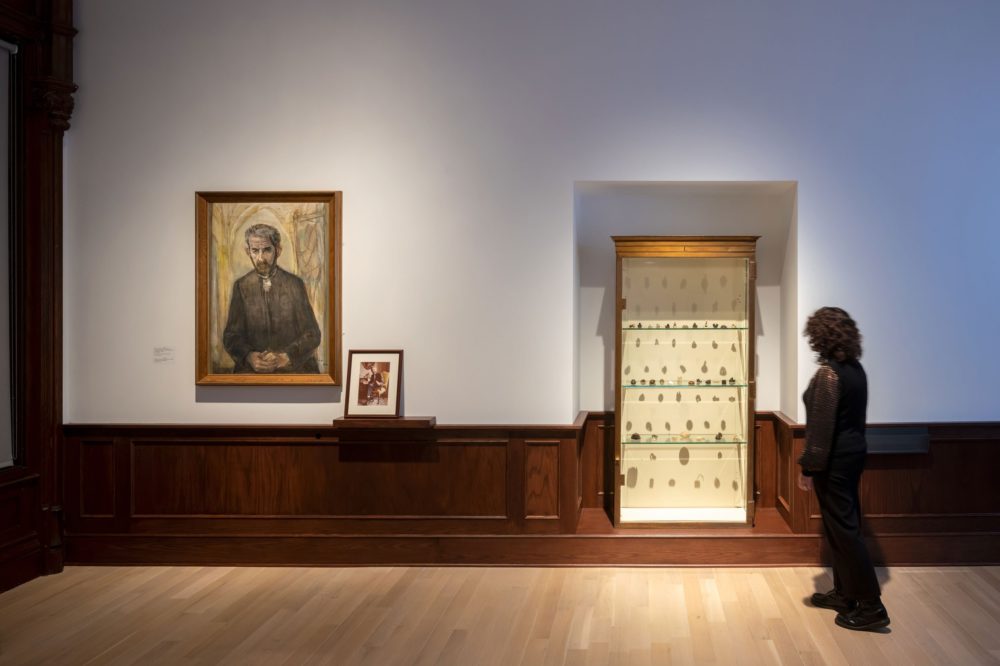
A major exhibition based on de Waal's celebrated family memoir took place at The Jewish Museum in New York. Designed by award-winning architects, Diller Scofidio + Renfro, this immersive exhibition brought together pieces from the Ephrussi’s collections from across the world to examine the ways in which objects can function as storytellers, symbols of resilience, and monuments of a family legacy.
A major exhibition based on de Waal's celebrated family memoir took place at The Jewish Museum in New York. Designed by award-winning architects, Diller Scofidio + Renfro, this immersive exhibition brought together pieces from the Ephrussi’s collections from across the world to examine the ways in which objects can function as storytellers, symbols of resilience, and monuments of a family legacy.
The centrepiece was the extraordinary collection of Japanese netsuke, hidden by a maid who concealed them from German officials in her mattress, and later returned them to the family after the war. The collection has since been handed down to subsequent generations, serving as a connection between the past and the present.
Photography: Iwan Baan

Edmund de Waal's first solo exhibition in Korea takes place this Spring, and brings together works from 2013 to the present day.

In this short, illustrated talk as part of the Bernard Leach Conference, Edmund de Waal will look at projects dealing with memory and restitution including his library of exile and exhibitions in Vienna, Paris and New York.

For the James L. Weinberg Distinguished Lecture at the Jewish Museum, New York, Edmund de Waal was in conversation with author and journalise Sandee Brawarsky.

Edmund de Waal launches a new annual talk in memory of the Oxford literary agent Felicity Bryan by discussing his friendship with her alongside his new book Letters to Camondo.
Edmund de Waal launches a new annual talk in memory of the Oxford literary agent Felicity Bryan by discussing his friendship with her alongside his new book Letters to Camondo.
Photo: Eamonn McCabe
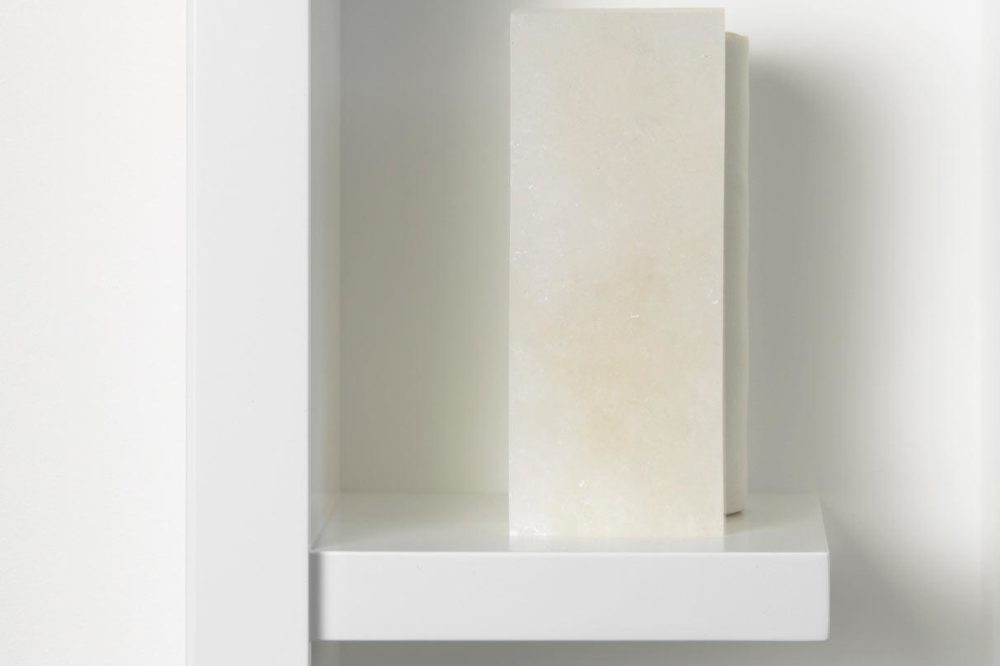
De Waal's 2016 piece things exactly as they are is included in the exhibition The Fourth Dimension at The Mashiko Museum of Ceramic Art, in conjunction with the Mashiko Museum Residency Program. The exhibition examines the way the shape of vessel is expressed in works by 33 artists both from Japan and further afield.
De Waal's 2016 piece things exactly as they are is included in the exhibition The Fourth Dimension at The Mashiko Museum of Ceramic Art, in conjunction with the Mashiko Museum Residency Program. The exhibition examines the way the shape of vessel is expressed in works by 33 artists both from Japan and further afield.
Photo: things exactly as they are, 2016 (detail). Photo by Mike Bruce.

A conversation with Edmund de Waal and E. Randol Schoenberg, Jewish genealogist and the well-known attorney who recovered the Klimt paintings from Austria. This event is part of the JewishGen series, run in conjunction with The Jewish Museum, New York and the Museum of Jewish Heritage in New York.
A conversation with Edmund de Waal and E. Randol Schoenberg, Jewish genealogist and the well-known attorney who recovered the Klimt paintings from Austria. This event is part of the JewishGen series, run in conjunction with The Jewish Museum, New York and the Museum of Jewish Heritage in New York.
Photography: Iwan Baan

This November, 100,000 copies of Der Hase mit den Bernsteinaugen, the German edition of de Waal's family memoir, will be given away across Vienna. Eine STADT. Ein BUCH (One City. One Book), an initiative which began in 2002, takes place in Vienna every year, where one book is selected, printed and distributed for free across the city. Previous years have included titles by Imre Kertesz, Toni Morrison, Maria Vargas Llosa and Michael Ondaatje.

In an episode for Always Authors, a new podcast featuring candid conversations between two authors, Edmund de Waal joins the acclaimed writer André Aciman in conversation about their work, lives, and favourite books.

To mark the 70th anniversary of Jewish Book Week, Edmund de Waal will deliver the keynote address on the final day of Jewish Book Week.
To mark the 70th anniversary of Jewish Book Week, Edmund de Waal will deliver the keynote address on the final day of Jewish Book Week.
Photo: Kings Place

Perdendosi is a limited edition set of twelve hand-printed original black and white photographs by Norman McBeath together with a direct and personal response to the photographs by Edmund de Waal, on display from 14 January at the Fine Art Society, Edinburgh.
Perdendosi is a limited edition set of twelve hand-printed original black and white photographs by Norman McBeath together with a direct and personal response to the photographs by Edmund de Waal, on display from 14 January at the Fine Art Society, Edinburgh.
Photography: Norman McBeath

As part of London Review of Books’ That Year Again series, Ange Mlinko, Don Paterson and Edmund de Waal discuss Rilke’s ‘savage creative storm’.

De Waal's latest book, Letters to Camondo, is a haunting sequence of imagined letters to the Count de Camondo – the owner of a Parisian palace filled with beautiful objects, turned into a memorial for his lost son.
De Waal's latest book, Letters to Camondo, is a haunting sequence of imagined letters to the Count de Camondo – the owner of a Parisian palace filled with beautiful objects, turned into a memorial for his lost son.
Count Moïse de Camondo was a Jewish collector and philanthropist who lived on the famous rue de Monceau in Paris, at the same time as the Ephrussi family (the forebears of Edmund de Waal, who famously appeared in The Hare with Amber Eyes). Like the Ephrussi, Count Camondo and his family were part of Belle Époque Parisian high society. They were also targets of anti-semitism.
Moïse de Camondo created a spectacular house, modelled on the Petit Trianon, and filled it with the greatest private collection of French eighteenth century art for his son Nissim to inherit. But when Nissim was killed in the First World War, it became a memorial – with the instruction that nothing be changed – and was bequeathed by Moïse on his death in 1935 to the French state.
The Musée Nissim de Camondo has remained unaltered since 1936. Over the past year, Edmund de Waal has had the run of the beautiful palace overlooking the park; its objects and its archives. Here, he reflects on the Count's story — on one hand a close-knit family, with a love of horse-riding, good food and fine furniture. On the other, a journey from Constantinople and the work of two generations to assimilate to Frenchness, before all that has been made is torn away.
The Count didn't live to see the horrific betrayal to come — with characteristic delicacy and care, de Waal informs him, and the reader, of what happened next, and what it might mean to create a memorial.
Click the below link to order a copy and view de Waal's list of five books that influenced the letters on bookshop.org
Photography: Edward Park
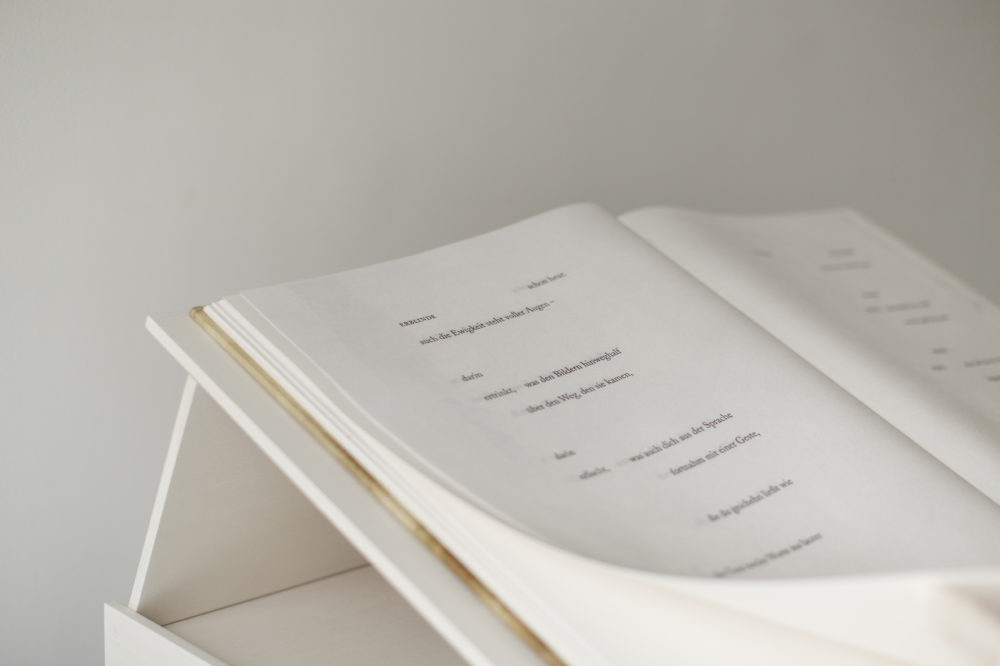
De Waal's artist's book breath featured in this exhibition organised by the University of Seville in conjunction with Ivorypress. An atlas folio bound in vellum, breath holds poems by Paul Celan, both in German and in translation by Pierre Joris, printed on three different papers, washed with porcelain slip, erased and rewritten by hand.
De Waal's artist's book breath featured in this exhibition organised by the University of Seville in conjunction with Ivorypress. An atlas folio bound in vellum, breath holds poems by Paul Celan, both in German and in translation by Pierre Joris, printed on three different papers, washed with porcelain slip, erased and rewritten by hand.
Photography: © Pablo Gómez-Ogando, courtesy Ivorypress

Gathering over 350 pieces dating from the Neolithic to the present day, the exhibition The Flames: The Age of Ceramics is an immersive exploration of the medium, a fresh, fruitful dialogue between objects from different periods and contexts that brings to light influences as well as coincidences. De Waal's 2016 piece, once is as good as never, is featured in the exhibition.
Gathering over 350 pieces dating from the Neolithic to the present day, the exhibition The Flames: The Age of Ceramics is an immersive exploration of the medium, a fresh, fruitful dialogue between objects from different periods and contexts that brings to light influences as well as coincidences. De Waal's 2016 piece, once is as good as never, is featured in the exhibition.

Edmund de Waal discusses his book Letters to Camondo in this event at MAK Vienna, introduced by journalist and author Wolfgang Popp.
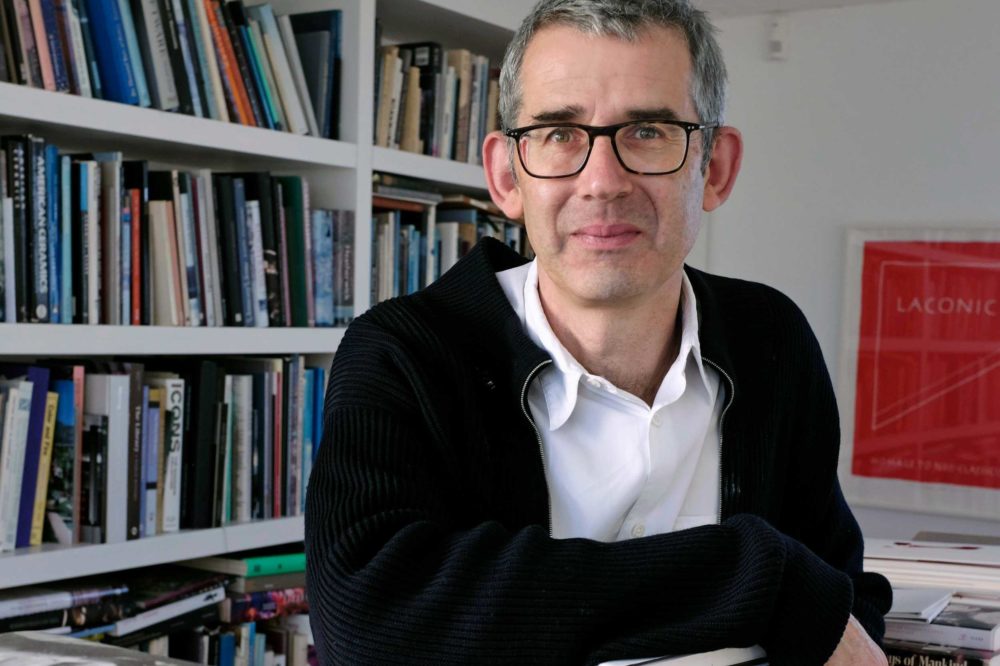
Edmund de Waal will give this year's Ruskin To-Day Brantwood Annual Lecture celebrating the life, work and legacy of John Ruskin. For this lecture, de Waal examines Ruskin's legacy of thinking on technology, materiality, consumption and value. De Waal will also reflect on how Ruskin has influenced his own artistic practice.
Edmund de Waal will give this year's Ruskin To-Day Brantwood Annual Lecture celebrating the life, work and legacy of John Ruskin. For this lecture, de Waal examines Ruskin's legacy of thinking on technology, materiality, consumption and value. De Waal will also reflect on how Ruskin has influenced his own artistic practice.
Photo: Eamon McCabe

As part of the Charleston Literary Festival, Tristram Hunt, director of the Victoria & Albert Museum and author of The Radical Potter: The Life and Times of Josiah Wedgwood, and Edmund de Waal explore their obsessions with ceramics and objects and how that has led to journeys into porcelain, abolitionism and the holocaust.
As part of the Charleston Literary Festival, Tristram Hunt, director of the Victoria & Albert Museum and author of The Radical Potter: The Life and Times of Josiah Wedgwood, and Edmund de Waal explore their obsessions with ceramics and objects and how that has led to journeys into porcelain, abolitionism and the holocaust.
Photo: Ben McKee

As part of Jewish Book Week, Edmund de Waal will be in conversation Washington Post Paris Correspondent James Mcauley, chaired by Anne Sebba.
As part of Jewish Book Week, Edmund de Waal will be in conversation Washington Post Paris Correspondent James Mcauley, chaired by Anne Sebba.
Photography: Porte Cochère of the Musée Nissim de Camondo, 63, rue de Monceau, circa 2007. © MAD, Paris / Jean-Marie del Moral

On the Financial Times Weekend Festival Arts Stage, Edmund de Waal talks to FT Arts Editor, Jan Dalley about Letters to Camondo, and about placing his contemporary work in dialogue with another era.
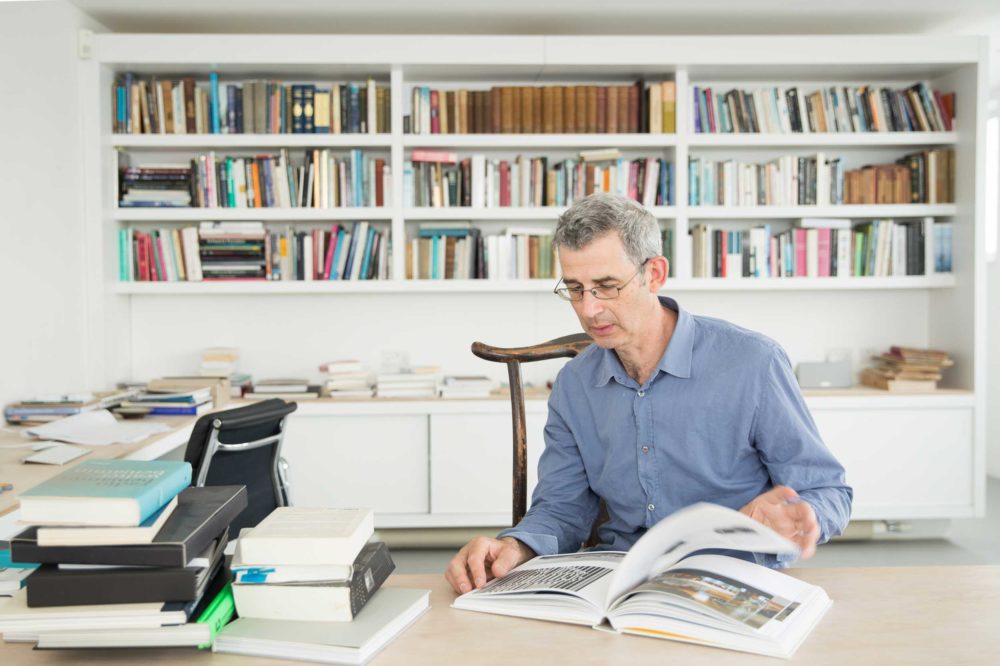
In this event, de Waal unpacks his deep fascination with the objects in the Musée de Camondo and what they reveal about his own personal and cultural history – with Lennie Goodings, author of A Bite of the Apple: A Life with Books, Writers and Virago.
In this event, de Waal unpacks his deep fascination with the objects in the Musée de Camondo and what they reveal about his own personal and cultural history – with Lennie Goodings, author of A Bite of the Apple: A Life with Books, Writers and Virago.
Photography: Ben McKee

For the new Maggie’s Cancer Support Centre at Southampton, de Waal has created a poetry library and a series of oak panel works inscribed with three poems written into porcelain slip.
For the new Maggie’s Cancer Support Centre at Southampton, de Waal has created a poetry library and a series of oak panel works inscribed with three poems written into porcelain slip.
Selected with his daughter, Anna, the books were generously donated by Chatto Books and the works directly from the artist. Designed by Amanda Levete and her team at AL_A in close relationship with landscaper, Sarah Price, the centre opened in July 2021.
Photography: Sandy Nairne, Alzbeta Jaresova

Bringing together miniature artworks from over 80 artists, this exhibition at Pallant House includes works by Augustus John, Vanessa Bell, Paul Nash, Sir Peter Blake and Richard Hamilton as well as new pieces by Rachel Whiteread, Damien Hirst, John Akomfrah, Tacita Dean and Lubaina Himid.
Bringing together miniature artworks from over 80 artists, this exhibition at Pallant House includes works by Augustus John, Vanessa Bell, Paul Nash, Sir Peter Blake and Richard Hamilton as well as new pieces by Rachel Whiteread, Damien Hirst, John Akomfrah, Tacita Dean and Lubaina Himid.
De Waal has contributed a miniature pot entitled and show and end, the title of which is taken from Emily Dickinson's poem about tiny and huge things.
Photography: Rob Harris

Join James McAuley and Edmund de Waal as they discuss this powerful history of Jewish art collectors in France, and how an embrace of art and beauty was met with hatred and destruction.
Join James McAuley and Edmund de Waal as they discuss this powerful history of Jewish art collectors in France, and how an embrace of art and beauty was met with hatred and destruction.
Photo: Room of Nissim de Camondo. Paris, Musée Nissim de Camondo. © MAD, Paris / Jean-Marie del Moral

sukkah (2019), originally created for a synagogue in the Venetian Ghetto as part of de Waal's installation psalm, is currently on loan to Canterbury Cathedral.
sukkah (2019), originally created for a synagogue in the Venetian Ghetto as part of de Waal's installation psalm, is currently on loan to Canterbury Cathedral.
The work has been installed in St Gabriel’s Chapel, in the Crypt of the Cathedral, a place famed for its striking early twelfth-century frescoes and Romanesque carvings of animals playing musical instruments.
“It is a great privilege to bring this work to a place that I have known and loved since childhood. Sukkah will have moved from the highest space of the Venetian Jewish Ghetto to deep within the oldest parts of Canterbury Cathedral. Both these spaces contain imagery of celebration and it feels appropriate to be announcing this on the eve of the two great festivals of Passover and Easter. I hope its resonance of vulnerability and protection, contemplation and prayer will be manifest here.”
- Edmund de Waal
The work, sukkah, was originally conceived for the Sukkah in the Canton Scuola synagogue in the Jewish Ghetto in Venice for the 2019 Venice Biennale. Sukkot, the Feast of the Tabernacles, is the festival that commemorates the forty years of wandering in the desert. The work is comprised of nine towers which appear to float above the table, each containing tall white porcelain vessels and leaning pieces of gilded steel that catch the light from the medieval stained-glass windows.
“We feel privileged and deeply moved to have Edmund’s work sukkah standing in St Gabriel’s Chapel in the crypt of Canterbury Cathedral at this significant time of year for both Jewish and Christian communities. It is a work which reminds us of the fragility not only of human life, but also of the shelters we construct during our human journeys. The light which shines through the ancient stained glass changes hour by hour and day by day, and the sense of ‘reflection’ becomes not only real as one observes its effect on the installation, but also an aspect of our mental and spiritual ability to reflect on our human condition and its capacity to journey beyond the seeming limitations we experience. It also becomes an invitation to journey on together in faith and hope for the future. Sukkah will enrich the Cathedral’s life in Holy Week and Easter by its presence among us.”
- The Very Revd Dr Robert Willis, Dean of Canterbury
Photography: Alzbeta Jaresova

As part of This Living Hand, the exhibition at the Henry Moore Foundation, Edmund de Waal has made a ’tsukubai’ - a hand-washing basin traditional to Japanese Zen gardens.
As part of This Living Hand, the exhibition at the Henry Moore Foundation, Edmund de Waal has made a ’tsukubai’ - a hand-washing basin traditional to Japanese Zen gardens.
In de Waal's words "I have made a place to pause, just outside the gallery, with water running over stone where you can wash your hands. It is a sculpture recollecting the stone basins in Japanese gardens. I’ve called it stone for two hands and water."
The exhibition opened on Weds 19 May 2021, in line with government guidelines. The gardens reopened to the public on 31 March.

After a year in lockdown, a new exhibition of Henry Moore's work, curated by de Waal for the Henry Moore Studios & Gardens, opened to the public. Located at the artist's former home in Hertfordshire, This Living Hand explores the role of touch and the iconography of the hand in Moore’s art.
After a year in lockdown, a new exhibition of Henry Moore's work, curated by de Waal for the Henry Moore Studios & Gardens, opened to the public. Located at the artist's former home in Hertfordshire, This Living Hand explores the role of touch and the iconography of the hand in Moore’s art.
The first exhibition of its kind, visitors are invited to touch a collection of Moore's work in bronze and stone, as well as a number of original carved benches, created by de Waal, from Hornton stone – one of Moore's favourite materials. Alongside these sculptural works, a room of drawings and prints chart Moore’s interest in the hand as a subject, from The Three Fates (1948) to the numerous studies of his own and other subjects’ hands, including those he made in 1978 of the Nobel Prize winner, Dorothy Hodgkin, who wanted her hands to be used as her portrait. Upstairs, de Waal has curated a wunderkammer of objects that Moore kept close by him at home, 'objects of sustenance and renewal'.
Moore believed that ‘tactile experience is very important as an aesthetic dimension in sculpture’. Throughout his career he repeatedly emphasised the importance of experiencing sculpture haptically, and often returned to the hand as a subject in his sculpture and drawings, studying its expressive power and symbolic values as Auguste Rodin and Michelangelo, two of his favourite artists, had done before him.
For de Waal, in This Living Hand, "we see a life of reflection on how hands become sculpture. We are returned to what knowledge our own hands hold.”
Image: Moore holding the plaster maquette for Reclining Figure: Hand 1976, (LH 707). Photo: Henry Moore Archive. Reproduced by permission of The Henry Moore Foundation

Edmund de Waal is in conversation with curator Richard Calvocoressi as part of the programme to accompany the exhibition The Human Touch at the Fitzwilliam Museum, Cambridge. This pre-recorded talk explores the creativity of the artist’s hands and the marks and traces they leave. The talk is followed by a live Q&A session with the exhibition curators.
Edmund de Waal is in conversation with curator Richard Calvocoressi as part of the programme to accompany the exhibition The Human Touch at the Fitzwilliam Museum, Cambridge. This pre-recorded talk explores the creativity of the artist’s hands and the marks and traces they leave. The talk is followed by a live Q&A session with the exhibition curators.
Photography: Ben McKee

In Refugee Week, Anne McElvoy and her guests, Edmund de Waal, Frances Stonor Saunders, Fariha Shaikh and Jasleen Kaur, look at what it means to have to move your family and belongings.
In Refugee Week, Anne McElvoy and her guests, Edmund de Waal, Frances Stonor Saunders, Fariha Shaikh and Jasleen Kaur, look at what it means to have to move your family and belongings.
Photography: Ben McKee

Hosted by the Jewish Museum, New York, a conversation between Edmund de Waal and writer Adam Gopnik to celebrate the launch of Letters to Camondo.
Hosted by the Jewish Museum, New York, a conversation between Edmund de Waal and writer Adam Gopnik to celebrate the launch of Letters to Camondo.
Photography: Portrait of Adam Gopnik by Brigitte Lacombe; portrait of Edmund de Waal by Tom Jamieson

In The Studio follows Edmund de Waal as he creates new site-specific work for the Musée Nissim de Camondo, Paris. Listen again here.
In The Studio follows Edmund de Waal as he creates new site-specific work for the Musée Nissim de Camondo, Paris. Listen again here.
Edmund de Waal guides us through his creative response to the haunting history of the Camondo family, the last of whom were killed at Auschwitz. Edwina Pitman follows him in his studio as he works on a multi-faceted installation for a unique setting, navigates the challenges of creating during lockdown and grapples with the notions of what it means to create a fitting memorial.
Photography: Ben McKee

For the London Library Lit Fest, Tom Stoppard and Edmund de Waal came together in conversation to discuss some of the themes and concerns they share in their work, including diaspora, displacement, art and libraries and the cultural particularity of pre-War Vienna.

Edmund de Waal discussed his most recent book, Letters to Camondo, at this online event with the How To Academy.
Edmund de Waal discussed his most recent book, Letters to Camondo, at this online event with the How To Academy.
Photography: Edward Park

In this live streamed event, Edmund de Waal discusses Letters to Camondo with Village Books, Dulwich.
In this live streamed event, Edmund de Waal discusses Letters to Camondo with Village Books, Dulwich.
Photography: Edward Park

An evening of art, science and deeply personal storytelling, with Edmund de Waal, Sam Lee, Horatio Clare, Suzanne O'Sullivan and Walter Isaacson.
An evening of art, science and deeply personal storytelling, with Edmund de Waal, Sam Lee, Horatio Clare, Suzanne O'Sullivan and Walter Isaacson.
Photography: Edward Park

Edmund de Waal joins Olivier Gabet for an online conversation, chaired by Tristram Hunt, in celebration of the publication of Letters to Camondo.
Edmund de Waal joins Olivier Gabet for an online conversation, chaired by Tristram Hunt, in celebration of the publication of Letters to Camondo.
Image: Victoria & Albert Museum

In this talk, hosted by Crafts, de Waal discuss the meaning of craft today, its relationship to contemporary art, and his new book, Letters to Camondo, out in April, with the curator and critic Glenn Adamson, Crafts’ editor-at-large.
In this talk, hosted by Crafts, de Waal discuss the meaning of craft today, its relationship to contemporary art, and his new book, Letters to Camondo, out in April, with the curator and critic Glenn Adamson, Crafts’ editor-at-large.
Photography: Rob McKeever

A musical celebration to mark the end of the installation of library of exile, before the books move to their permanent home in Mosul. Musician, composer and television presenter Soumik Datta presented an evening of performances inspired by the installation.
A musical celebration to mark the end of the installation of library of exile, before the books move to their permanent home in Mosul. Musician, composer and television presenter Soumik Datta presented an evening of performances inspired by the installation.
The event included readings from Edmund de Waal and other acclaimed guest writers who have participated in the programme of online discussions inspired by the library throughout 2020.
With the installation now closed to the public, the books within the library will travel to their final home in Iraq, at the University of Mosul, with the kind participation of Book Aid International.
This event was presented in collaboration with English PEN, Soumik Datta Arts and the United Nations Regional Information Centre.
The event was broadcast on the British Museum Events YouTube channel at 18.00 on Friday 29 January and included live captioning.
Photo: Hélène Binet

This exhibition at Gagosian's Davies Street gallery brings together a group vessels made by Edmund de Waal during lockdown. This is the first time in sixteen years that de Waal has made single works that are not parts of installations. They are specifically designed to be touched and held in the hand.
This exhibition at Gagosian's Davies Street gallery brings together a group vessels made by Edmund de Waal during lockdown. This is the first time in sixteen years that de Waal has made single works that are not parts of installations. They are specifically designed to be touched and held in the hand.
De Waal comments, “I made these pots in lockdown during the spring and early summer. I was alone in my studio and silent and I needed to make vessels to touch and hold, to pass on. I needed to return to what I know—the bowl, the open dish, the lidded jar. When you pick them up you will find the places where I have marked and moved the soft clay. Some of these pots are broken and patched on their rims with folded lead and gold; others are mended with gold lacquer. Some hold shards of porcelain.
In the studio I had two old Chinese bowls from the Song dynasty. One was patched on the rim with iron. The other had a beautiful thin golden thread running from the rim, repaired using the Japanese art of kintsugi. Kintsugi is not an art of erasure—the invisible mend, the erasing of a mistake—but rather a way of marking loss. Both these bowls were central to the making of this work.
These black vessels show the flux of glaze. The white dishes have been fired without glaze so that each mark is present. They are bone clear. These are some pots for the hands, for this winter.”
The exhibition was installed so that it could also be seen from the street.
Photo: Alzbeta Jaresova

An exhibition of works in stone and alabaster by Edmund de Waal at the New Art Centre at Roche Court, Wiltshire.
An exhibition of works in stone and alabaster by Edmund de Waal at the New Art Centre at Roche Court, Wiltshire.
As de Waal's said in 2020: "In these last months, I realised how much I wanted to make things for people to touch. I hope they feel old, weathered, 'known and handled' to borrow David Jones' words. I've called them tacet. Silence, rest."
Click the play button below for a short film about the exhibition.
Photography: Alzbeta Jaresova

This exhibition at Gagosian, Hong Kong, featured a new body of work inspired by the Chinese monk Hanshan’s practice of writing on rocks, tree trunks, and cave walls.
This exhibition at Gagosian, Hong Kong, featured a new body of work inspired by the Chinese monk Hanshan’s practice of writing on rocks, tree trunks, and cave walls.
De Waal’s new works are made through a cycle of inscription and effacement. He begins by coating a wood panel in liquid kaolin; while the slip is still wet, he floats flecks of gold leaf and writes lines of Hanshan’s poetry in graphite, oil stick, and charcoal. He then brushes these marks with additional layers of kaolin slip, repeating the process multiple times to produce a “fugitive poem,” an ethereal palimpsest of text that emulates the haze of memory.
Photography: Stephen Head

A hymn to writers in exile — The Economist. From Venice, to Dresden and now London, Edmund de Waal’s library of exile makes its final stop at the British Museum.
A hymn to writers in exile — The Economist. From Venice, to Dresden and now London, Edmund de Waal’s library of exile makes its final stop at the British Museum.
A temporary pavilion, designed as a place of dialogue and contemplation, where visitors are encouraged to sit and read a collection of over 2,000 books by writers who have experienced exile from across the world. Almost all the books are translations, exploring the idea of language as migration. The library can also be explored via an online catalogue libraryofexile.com.

For this Goethe-Institut event, Edmund de Waal joins Rosie Goldsmith, A.L. Kennedy, Baroness Mary Goudie, Niloo Shafari, and Sharmaine Lovegrove to consider Europe and reflect what they are feeling during this time, especially in the midst of the Covid 19 crisis which makes us feel boundaries and distances more acutely again.
For this Goethe-Institut event, Edmund de Waal joins Rosie Goldsmith, A.L. Kennedy, Baroness Mary Goudie, Niloo Shafari, and Sharmaine Lovegrove to consider Europe and reflect what they are feeling during this time, especially in the midst of the Covid 19 crisis which makes us feel boundaries and distances more acutely again.
Photo: Ben McKee

This panel discussion celebrates the role of translation in breaking down barriers. Chaired by Associate Editor (Culture) for the Guardian and English PEN Trustee, Claire Armitstead, it features Syrian translator and author of The Frightened Ones, Dima Wannous; Chinese-born British poet and author of Red Dust, Ma Jian; and his translator and interpreter, Flora Drew.
This panel discussion celebrates the role of translation in breaking down barriers. Chaired by Associate Editor (Culture) for the Guardian and English PEN Trustee, Claire Armitstead, it features Syrian translator and author of The Frightened Ones, Dima Wannous; Chinese-born British poet and author of Red Dust, Ma Jian; and his translator and interpreter, Flora Drew.
This is one of four thought-provoking events in a series exploring the themes inspired by the library of exile, presented in collaboration with its creator Edmund de Waal and English PEN
Photo: Hélène Binet
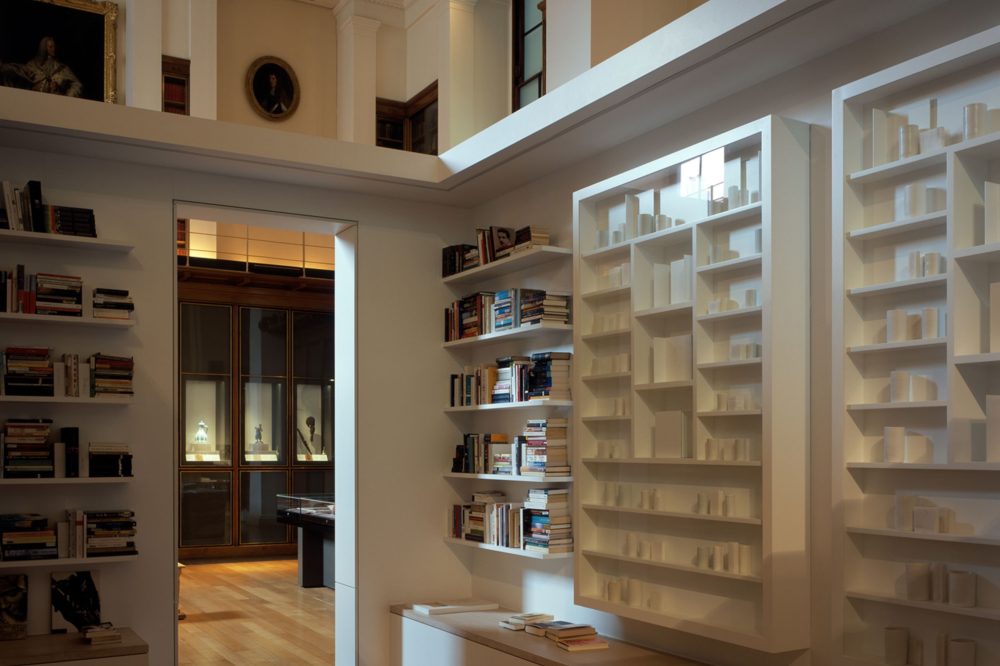
The discussion is chaired by English PEN President, Philippe Sands QC, and features contemporary artist and writer Edmund de Waal; Chilean novelist Alia Trabucco Zerán, whose debut novel La Resta (The Remainder) was shortlisted for the Man Booker Prize; and British Palestinian fiction-writer Selma Dabbagh, whose first novel, Out of It, set between London, Gaza and the Gulf, was listed as a Guardian Book of the Year in 2011 and 2012.
The discussion is chaired by English PEN President, Philippe Sands QC, and features contemporary artist and writer Edmund de Waal; Chilean novelist Alia Trabucco Zerán, whose debut novel La Resta (The Remainder) was shortlisted for the Man Booker Prize; and British Palestinian fiction-writer Selma Dabbagh, whose first novel, Out of It, set between London, Gaza and the Gulf, was listed as a Guardian Book of the Year in 2011 and 2012.
This is one of four thought-provoking events exploring the themes inspired by the library of exile, presented in collaboration with Edmund de Waal and human rights organisation English PEN
Photo: Hélène Binet

Join Richard Ovenden, director of the world-famous Bodleian Libraries, as he discusses his new publication, Burning the Books, with Edmund de Waal.
Join Richard Ovenden, director of the world-famous Bodleian Libraries, as he discusses his new publication, Burning the Books, with Edmund de Waal.
Their conversation will explore the historic destruction of libraries and archives, many of the names of which are written into the walls of the library of exile.
As Ovenden explains, libraries are far more than stores of literature. Through preserving legal documents such as Magna Carta and records of citizenship, they also support the rule of law and the rights of citizens. Today, the knowledge they hold on behalf of society is under attack as never before.

This panel discussion explores the interconnected nature of climate change and migration and accompanies the current British Museum / Citi exhibition, Arctic: culture and climate and Edmund de Waal's library of exile installation.
This panel discussion explores the interconnected nature of climate change and migration and accompanies the current British Museum / Citi exhibition, Arctic: culture and climate and Edmund de Waal's library of exile installation.
Panellists include indigenous Arctic writer, spoken word poet and curator, Taqralik Partridge; Shaul Bassi, Director of the International Center for the Humanities and Social Change at Ca'Foscari University of Venice; and James Thornton, an environmental lawyer and writer. The New Statesman named Thornton as one of 10 people who could change the world.
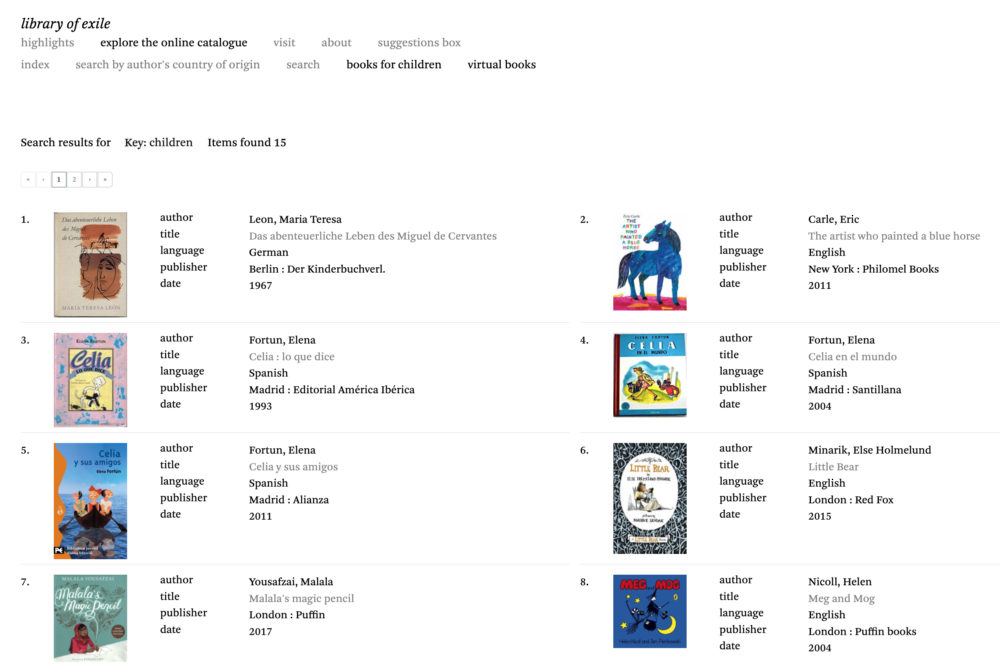
After its time at the British Museum, the library of exile was dismantled and all the books donated to the University of Mosul's library collection, destroyed by Isis in 2015. The online catalogue, however, remains live. Explore and search the holdings by language, author, category or country.
After its time at the British Museum, the library of exile was dismantled and all the books donated to the University of Mosul's library collection, destroyed by Isis in 2015. The online catalogue, however, remains live. Explore and search the holdings by language, author, category or country.

Edmund de Waal joins Whitechapel Gallery director Iwona Blazwick to discuss the exhibition Kai Althoff goes with Bernard Leach, on view until 10 January 2021.
Edmund de Waal joins Whitechapel Gallery director Iwona Blazwick to discuss the exhibition Kai Althoff goes with Bernard Leach, on view until 10 January 2021.
Photography: Ben McKee

A timely and urgent discussion exploring how literature can represent the experience of migration and exile, as part of Edmund de Waal’s library of exile at the British Museum.
A timely and urgent discussion exploring how literature can represent the experience of migration and exile, as part of Edmund de Waal’s library of exile at the British Museum.
Chaired by de Waal, it features Booker-shortlisted novelist and human rights activist Elif Shafak, EBRD Prize-winning writer and journalist Hamid Ismailov, and world-renowned journalist, broadcaster and writer Kavita Puri.
This is one of four thought-provoking events exploring the themes inspired by the library of exile, presented in collaboration with de Waal, English PEN, and the British Museum.
The installation and its accompanying public programme has been made possible with the support of the AKO Foundation.
Click the below link to view a recording of the discussion.
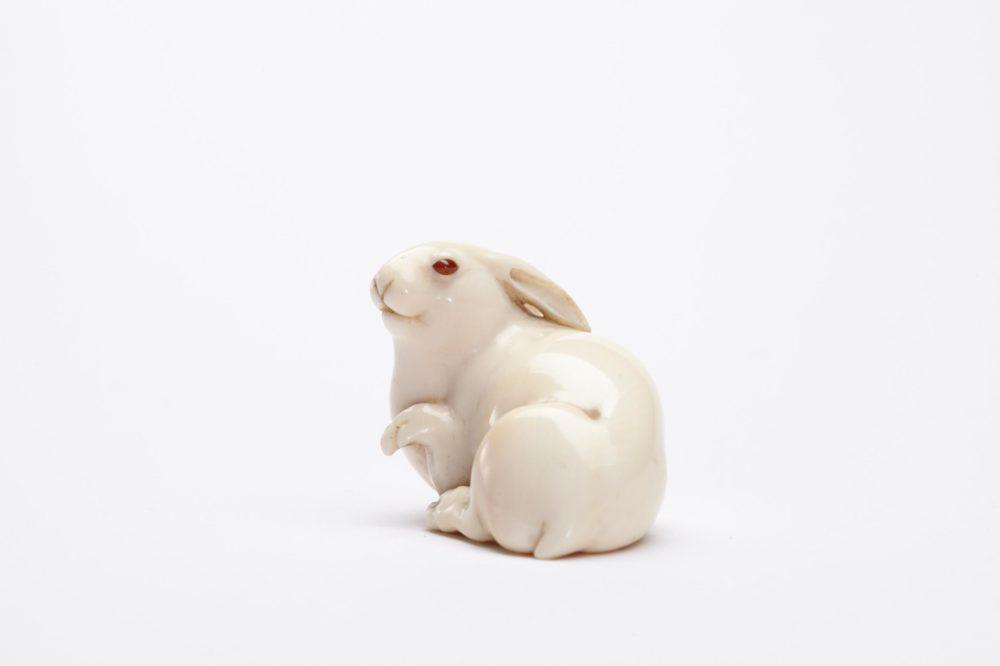
The Ephrussi Family Archive, donated to the Jewish Museum by the de Waal family, will go on display in this special exhibition along with 157 netsuke from Edmund de Waal's collection.
The Ephrussi Family Archive, donated to the Jewish Museum by the de Waal family, will go on display in this special exhibition along with 157 netsuke from Edmund de Waal's collection.
Photography: Michael Harvey

This virtual tour documents Edmund de Waal's installation of site-specific sculptures which were displayed in The Frick Collections's main galleries alongside works from the permanent collection.
This virtual tour documents Edmund de Waal's installation of site-specific sculptures which were displayed in The Frick Collections's main galleries alongside works from the permanent collection.
Photography: Christopher Burke
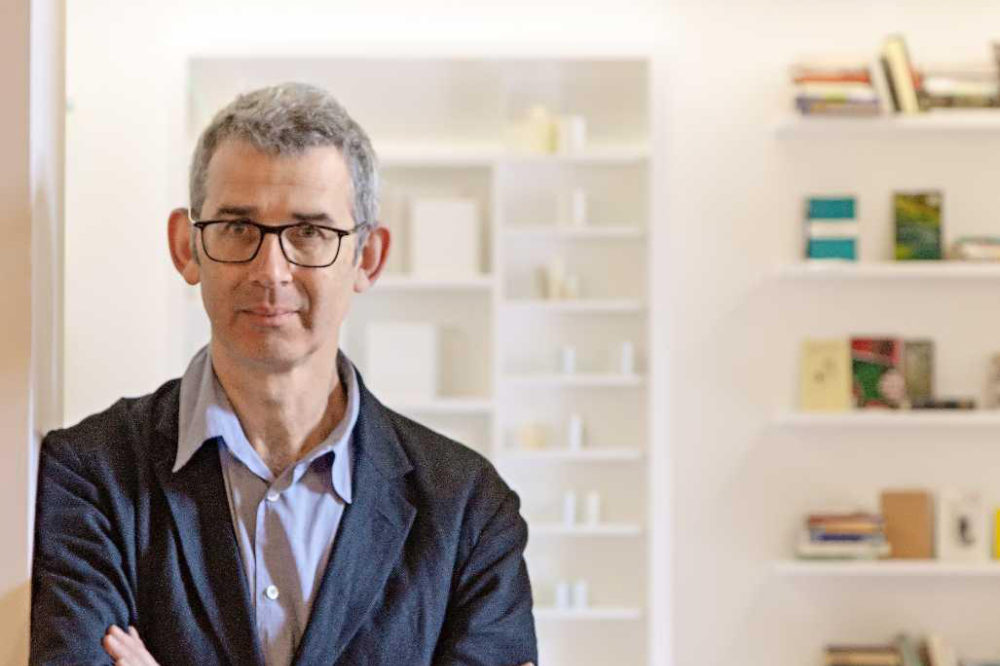
Over the coming weeks, PEN Transmissions, in collaboration with the British Museum and Edmund de Waal, is publishing a series of essays on the theme of exile. This series speaks to de Waal’s library of exile, currently housed at the Museum. In this interview to introduce the series, de Waal speaks to Hannah Trevarthen (English PEN’s Events and Partnerships Manager) about the installation.
Over the coming weeks, PEN Transmissions, in collaboration with the British Museum and Edmund de Waal, is publishing a series of essays on the theme of exile. This series speaks to de Waal’s library of exile, currently housed at the Museum. In this interview to introduce the series, de Waal speaks to Hannah Trevarthen (English PEN’s Events and Partnerships Manager) about the installation.
Photography: Fulvio Orsenigo

In this episode of The Modern House Podcast, Matt Gibberd speaks to Edmund de Waal about his work, life and home, as well as his top three living spaces around the world.

Edmund de Waal will be in conversation with Aanchal Malhotra, whose book Remnants of Partition is included in the library of exile. Watch online at Jaipur Literary Festival's website, link below.

A new panel piece, titled elegie, has been made especially for a group show staged by Gagosian, now open in New York. The exhibition traces the resonance of Rainer Maria Rilke’s poetry through artworks spanning the past 150 years.
A new panel piece, titled elegie, has been made especially for a group show staged by Gagosian, now open in New York. The exhibition traces the resonance of Rainer Maria Rilke’s poetry through artworks spanning the past 150 years.
Rilke’s writing has been a constant touchstone for de Waal. This work is one of his first to use porcelain in liquid form, painted onto wood panel over gold leaf and written into with text.

Edmund de Waal will be discussing the library of exile as part of Jewish Book Week in this special event.
Edmund de Waal will be discussing the library of exile as part of Jewish Book Week in this special event.
Photography: Ben McKee

A Quiet Corner in Time began as a sound work created by the composer Simon Fisher Turner for de Waal’s architectural intervention –one way or other– at the Schindler House, L.A., in 2018-19. It has since developed into a standalone album release with Mute Records.
A Quiet Corner in Time began as a sound work created by the composer Simon Fisher Turner for de Waal’s architectural intervention –one way or other– at the Schindler House, L.A., in 2018-19. It has since developed into a standalone album release with Mute Records.
Out on Mute on vinyl, CD and digitally on 27 March 2020. Limited to 1000 copies pressed on white vinyl with foil blocking. Includes sleeve notes and digital copy.
Photography: Edmund de Waal studio

The library of exile, which formed part of de Waal's exhibition psalm in Venice earlier this year, is now at the Staatliche Kunstammlungen, Dresden.
The library of exile, which formed part of de Waal's exhibition psalm in Venice earlier this year, is now at the Staatliche Kunstammlungen, Dresden.
The library comprises more than 2,000 volumes in almost all the languages of the world written by exiled authors from antiquity to the present day.
The exhibition is accompanied by a full programme of events, more detail can be found here.
An online catalogue of the library's holdings is also available to explore here.

A reflection on flight and return, loss and restitution and the cross-border role of literature.
A reflection on flight and return, loss and restitution and the cross-border role of literature.
A conversation between Edmund de Waal, artist and author, Nora Pester, owner of the Jewish publishing house Hentrich & Hentrich Leipzig / Berlin, and Gilbert Lupfer, board member of the German Lost Art Foundation. Moderation: Léontine Meijer-van Mensch, Director of the Ethnological Museums in Leipzig, Dresden and Herrnhut.
The event is in English and participation is free of charge.
Photography: Oliver Killig

Using the diary of Polish-Jewish teenager Renia Spiegel as inspiration, Edmund de Waal explored the ability of personal stories to tell difficult truths, joined by translators Marta Dziurosz and Anna Blasiak, and chaired by writer Lisa Appignanesi.

In this interview, Edmund de Waal discussed his installation library of exile, in the second location of its tour at the SKD, Dresden.

Temporary installation of new work at The Frick Collection, its first ever exhibition of a contemporary artist in the permanent galleries.
Temporary installation of new work at The Frick Collection, its first ever exhibition of a contemporary artist in the permanent galleries.
For this unique opportunity, de Waal created a series of site-specific sculptures made of porcelain, steel, gold, marble and glass in response to particular rooms and objects in the collection. These works were displayed in the museum's main galleries alongside works from the permanent collection.
To coincide with the exhibition, the museum published the third volume of its Frick Diptych series, pairing an essay by curator Charlotte Vignon with a text by de Waal. Together they offer fresh insight into a pair of porcelain candelabra by Pierre Gouthière, the French eighteenth-century chaser and gilder.
Photography: Christopher Burke

An exhibition of new and recent installations at Galerie Max Hetzler, Berlin, exploring the boundaries between text and sculpture, inspired by the work of the modernist Swiss writer, Robert Walser.
An exhibition of new and recent installations at Galerie Max Hetzler, Berlin, exploring the boundaries between text and sculpture, inspired by the work of the modernist Swiss writer, Robert Walser.
Walser's literary output is the central inspiration behind de Waal's second solo exhibition in Berlin. Walser’s so-called 'pencil method' - an obsessive form of notation in microscript - allowed him to explore the immersive qualities of writing, something which has long held great significance for de Waal; "I love his writings...the way he made texts. I love his understanding of making as a way of marking time. Text can be sculpture, sculpture a sort of speech".
In response to this idea, de Waal made a new series of sculptures - free-standing vitrines holding paper-thin sheets of porcelain, embossed with his own handwritten texts, which are leant or stacked like pages of a notebook against vessels or marble fragments. Some hold these porcelain elements without any vessel forms - the first installations of their kind. For the 10m-long wall in the Goethestraße gallery, he also made his first site-specific text piece for Berlin. Gilded with sheets of gold leaf and overpainted with kaolin slip, de Waal wrote into the surface, transcribing his own Walser-inspired texts and microscripts.

Writer Tracy Chevalier met Edmund de Waal at his studio for BBC Radio 4's Only Artists programme.

A major two-part exhibition in the Jewish Museum and the Ateneo Veneto, Venice.
A major two-part exhibition in the Jewish Museum and the Ateneo Veneto, Venice.
New installations of porcelain, marble and gold will reflect the literary and musical heritage of this extraordinary place. The intention is to animate spaces that are little known and little understood by visitors to the Biennale and to bring new audiences into the Ghetto.
The second part of the work will be a pavilion based at the Ateneo Veneto, the fifteenth-century building near the Fenice Opera House that has been an historic centre for cultural debate in Venice. Here, de Waal is constructing a small building within the main space that will house 2,000 books by exiled writers, from Ovid to the present day.
All the books will be in translation, reflecting the idea of language as migration. Four vitrines of porcelain vessels, based on Daniel Bomberg’s famous Renaissance printing of the Talmud, will hang on the walls amongst the books. The structure itself will have an exterior coated with porcelain, laid over gold leaf, into which de Waal will inscribe the names of the lost libraries of the world. Inside there will be spaces to sit and read. It will be a place of contemplation and a place of dialogue.
Throughout the Biennale there will be a rich programme of events, performances, readings, conversations and debate. The intention is to bring the experiences of contemporary writers in exile into focus and to celebrate the works in translation. There will also be events that focus on the cultures of Jewish Venice, on the Psalms, on contemporary poetry and on publishing.
Edmund de Waal said: “This is the project I have always dreamed of doing. It is about exile - what it means to have to move to another country, to speak another language. It brings new installations based on the Psalms, the poetry of exile, into some of the most beautiful spaces of the Ghetto, the first time some of these spaces have been used for contemporary art. And my library for the Ateneo - two thousand books within a porcelain-covered pavilion - will be the most significant sculpture of my life. It will be a new library reflecting Venice’s thousand years as a place of translation, a space to sit and read and be.”

As part of the Frieze Masters talks programme, Edmund de Waal will be discussing the work of Cy Twombly with Christine Kondoleon of the Museum of Fine Arts, Boston.

To accompany the exhibition The Peacock Room in Blue and White, currently on view in the Freer Gallery, Edmund de Waal presents a discussion about displays of Asian ceramics in America and Europe.
To accompany the exhibition The Peacock Room in Blue and White, currently on view in the Freer Gallery, Edmund de Waal presents a discussion about displays of Asian ceramics in America and Europe.
Photo: Smithsonian's Freer and Sackler Galleries - The Peacock Room, CC BY-SA 2.0, Licence details

Edmund de Waal and actress Rita Moreno have been selected for the 2019 Harman/Eisner Artist in Residence program with the Aspen Institute.
Edmund de Waal and actress Rita Moreno have been selected for the 2019 Harman/Eisner Artist in Residence program with the Aspen Institute.
The Harman/Eisner Artist in Residence program explores the work of selected artists and provides forum for their approach to society’s current challenges. As part of the residency, de Waal and Moreno will participate at the Aspen Ideas Festival and engage in other Institute activities in Aspen, New York, Washington DC, and elsewhere.
“I have long appreciated the work of the Aspen Institute and the talented individuals devoted to its mission. It is a huge honour to now – through the Harman/Eisner Artist in Residence program – be counted amongst them.” – Edmund de Waal

An International Symposium for the psalm cultural programme in Venice.
An International Symposium for the psalm cultural programme in Venice.
A two-day symposium bringing together voices from writers, curators, artists and historians from across the globe, including Mehnaz Afridi, Alessandro Bertoni, Tom Cartelli, John Champagne, Marc Epstein, Yoel Finkelman, Eva Hoffman, Mary Hoffman, Jacqueline Nicholls, Fania Oz-Salzberger, Dorit Raines, Bill Sherman, Gretchen Starr Le Beau, Murray Baumgarten, Margaret Brose, Simon Levis Sullam, Daniel Vogelmann and Yigal Zalmona.
The Friday afternoon concludes with a conversation between Edmund de Waal and the renowned Israeli author, David Grossman, at the Auditorium Santa Margherita.

Edmund de Waal spoke at the Financial Times Weekend Festival, in the How to Spend It tent with Lucia van der Post, and in the Arts tent with Jan Dalley.
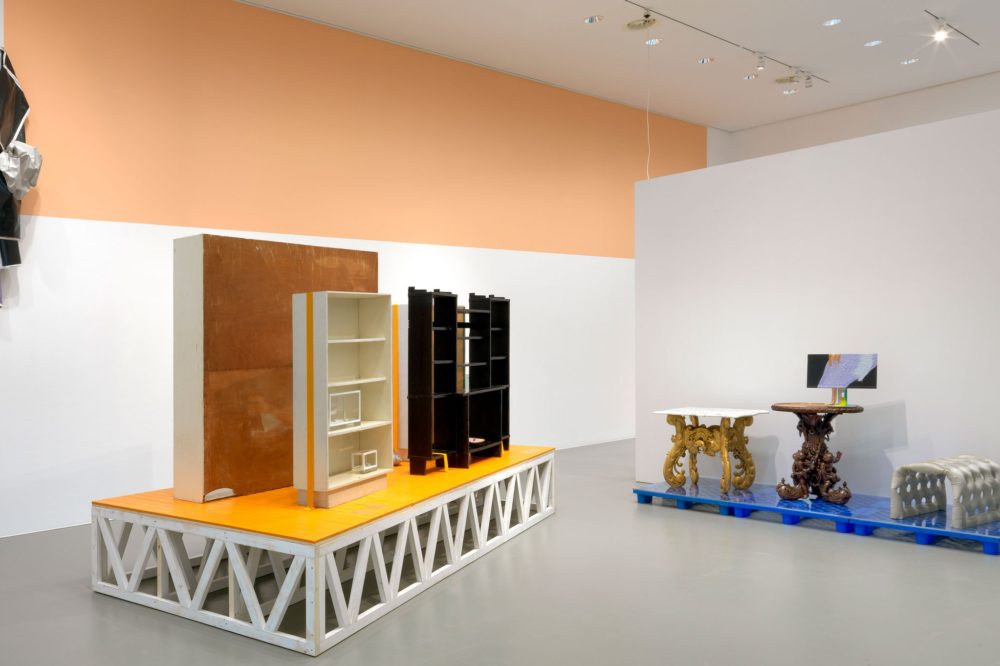
art without subject matter, I and II, are on show at the Centraal Museum in Utrecht, as part of Stuff Matters, a retrospective exhibition of works by Jessica Stockholder.
art without subject matter, I and II, are on show at the Centraal Museum in Utrecht, as part of Stuff Matters, a retrospective exhibition of works by Jessica Stockholder.
Acting as both artist and curator, Stockholder has selected over 60 items from more than 45 artists and makers. By combining these works in unexpected ways, intriguing relationshops emerge between artists, artisans and designers from Bart van der Leck to Helen Price and from Gustave Courbet to Gerrit Rietveld.

In this two-part talks series at The Frick Collection, New York, in conjunction his exhibition Elective Affinities, de Waal is in conversation with writer Adam Gopnik (10 October) and artist Sally Mann (8 November) about art, writing and other topics.
In this two-part talks series at The Frick Collection, New York, in conjunction his exhibition Elective Affinities, de Waal is in conversation with writer Adam Gopnik (10 October) and artist Sally Mann (8 November) about art, writing and other topics.
Photography: Christopher Burke

Delivered at the opening of Elective Affinities, this lecture explores de Waal's long relationship with the Frick and the meanings of collecting within his own life and artistic practice. Click below to play.
Delivered at the opening of Elective Affinities, this lecture explores de Waal's long relationship with the Frick and the meanings of collecting within his own life and artistic practice. Click below to play.
Photography: Christopher Burke

Part of the psalm cultural programme, a special series of events, curated together with the Ca’ Foscari University of Venice. For more details, please see the psalm website.
Part of the psalm cultural programme, a special series of events, curated together with the Ca’ Foscari University of Venice. For more details, please see the psalm website.
For this event, Edmund de Waal was joined by Lisa Appignanesi, Laura Forti, Helon Habila, Danielle McLaughlin, Sabine Scholl at the Ateneo Veneto, Venice.
Photo: Fulvio Orsenigo

In this illustrated lecture, de Waal explores the way he works and some of the connections between his family stories and most recent exhibitions and projects in Vienna, at the Venice Biennale, and at the Frick Collection, New York.
In this illustrated lecture, de Waal explores the way he works and some of the connections between his family stories and most recent exhibitions and projects in Vienna, at the Venice Biennale, and at the Frick Collection, New York.
Photo: Fulvio Oresnigo

This year's Kirker Lecture coincides with the unveiling of Edmund de Waal's major work for the Ghetto in Venice. Drawing on the themes of his psalm project - the poetry of exile, the co-existence of different communities and languages and the history of translation in Venice over the course of a thousand years, Edmund de Waal considers the rich heritage of the Ghetto as a place of exchange in many different senses. This event is in aid of Venice in Peril.
This year's Kirker Lecture coincides with the unveiling of Edmund de Waal's major work for the Ghetto in Venice. Drawing on the themes of his psalm project - the poetry of exile, the co-existence of different communities and languages and the history of translation in Venice over the course of a thousand years, Edmund de Waal considers the rich heritage of the Ghetto as a place of exchange in many different senses. This event is in aid of Venice in Peril.
Photo: Fulvio Orsenigo

For breath, Edmund de Waal was invited to work across Ivorypress’s three different spaces: its publishing house, exhibition space and bookshop. At the heart of this project is an Artist’s Book, published by Ivorypress: a project which has spanned many years, looking hard into what books are, how they feel and their presence in the world.
For breath, Edmund de Waal was invited to work across Ivorypress’s three different spaces: its publishing house, exhibition space and bookshop. At the heart of this project is an Artist’s Book, published by Ivorypress: a project which has spanned many years, looking hard into what books are, how they feel and their presence in the world.
It is a homage to Romanian-born poet Paul Celan, a book about slowing down. To accompany the Artist’s Book, de Waal has made a series of 17 new works, including vitrines, shelves and diptychs conceived as open books, which take inspiration from the Spanish artist Francisco de Zurbarán, the writer Federico García Lorca, and also from Celan. There is porcelain, marble and gilding; there is gold leaf and platinum, acknowledging the silver dishes in Zurbarán’s paintings. There are objects hidden from view and there are repetitions. Alongside these works there is a reading room, a selection of 100 books inviting visitors to sit down and read. The Artist’s Book, the exhibition, and the reading room are conceived as a single project.

This short film on the making of the Edmund de Waal's artist's book with Ivorypress, Madrid, explores process, materials, and the reasons for creating this limited edition piece. Click the play button below to watch.
This short film on the making of the Edmund de Waal's artist's book with Ivorypress, Madrid, explores process, materials, and the reasons for creating this limited edition piece. Click the play button below to watch.
Photography: © Pablo Gómez-Ogando, courtesy of Ivorypress

This March, Edmund de Waal will be contributing to an evening held in honour of the alchemist and inventor, Johann Friedrich Böttger, on the 300th anniversary of his death. De Waal will be reading from his most recent book, The White Road (2015), and discussing Böttger’s legacy, along with that of his mentor, Ehrenfried Walther von Tschirnhaus.
This March, Edmund de Waal will be contributing to an evening held in honour of the alchemist and inventor, Johann Friedrich Böttger, on the 300th anniversary of his death. De Waal will be reading from his most recent book, The White Road (2015), and discussing Böttger’s legacy, along with that of his mentor, Ehrenfried Walther von Tschirnhaus.
De Waal will also be revealing his plans for a new installation commissioned for the Porzellansammlung’s extraordinary collection.
Admission is free. Please click below for more information and use the Anmelden button to register.
Photo: Page from Böttger's notebook showing his first porcelain tests, 15 January 1708. © Meissen Couture.

The annual Gomes Lecture at Emmanuel College, Cambridge, delivered this February by Edmund de Waal, was entitled In Touch: Objects, Families, Stories. Previous lecturers include Neil McGregor, Sandy Nairne, and Professor Alison Richard. Click the speaker icon below for an audio recording of the lecture.
The annual Gomes Lecture at Emmanuel College, Cambridge, delivered this February by Edmund de Waal, was entitled In Touch: Objects, Families, Stories. Previous lecturers include Neil McGregor, Sandy Nairne, and Professor Alison Richard. Click the speaker icon below for an audio recording of the lecture.
Photo: Ben McKee
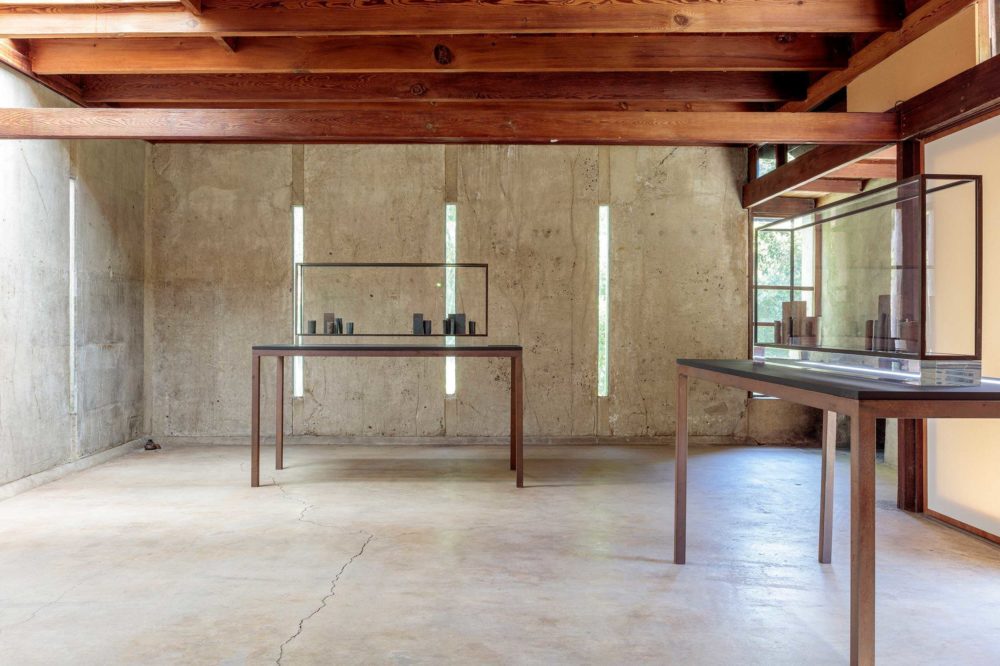
In autumn 2018, de Waal’s first architectural intervention in America opened at the Schindler House: a landmark of West Coast Modernism, built in 1922 in West Hollywood by Viennese émigré architect, Rudolph Schindler.
In autumn 2018, de Waal’s first architectural intervention in America opened at the Schindler House: a landmark of West Coast Modernism, built in 1922 in West Hollywood by Viennese émigré architect, Rudolph Schindler.
Conceived as a modular, changeable live-work building for two families, the house became a site of forward-thinking aesthetic, cultural and political activity, frequented by architects, dancers and artists from Frank Lloyd Wright to John Cage.
For de Waal, the Schindler House 'is an idea about beginnings. It stands as an attempt to create a place for both cooperative living and cooperative practice, to reset the conditions in which a modern family could live and experiment...The last decades of travelling to Vienna have made me think of what it might mean to be an émigré and build a house, to question what you bring with you when you start again so definitively.’ The exhibition included recent works, made in direct response to the materials and spaces of the house, and a sound piece conceived with the composer, Simon Fisher Turner, 'a layered memory soundscape of Vienna through its Raumplan, its volumes’.

Wayne McGregor's ballet, Yugen, was selected by the Guardian as one of their top ten dance shows of the year. The ballet, with sets designed by Edmund de Waal, was set to Leonard Bernstein's Chichester Psalms (1965), and commissioned to celebrate the centenary of Bernstein's birth.
Wayne McGregor's ballet, Yugen, was selected by the Guardian as one of their top ten dance shows of the year. The ballet, with sets designed by Edmund de Waal, was set to Leonard Bernstein's Chichester Psalms (1965), and commissioned to celebrate the centenary of Bernstein's birth.
Photo © ROH, 2018. Photographed by Andrej Uspenski.

De Waal's first exhibition in San Francisco opened at Gagosian this September. The new body of work brings together porcelain vessels with fragments of text by poets including Emily Dickinson, John Cage, Rilke and Wallace Stevens, whose work lends the exhibition its title. De Waal has referenced poetry in his work for over 20 years but, as he describes it, "here I’m trying to come closer to what it feels like to remember a poem, to carry it with you through the decades, a phrase or image coming into your life and making the world feel denser with possibility."

The Museum of Royal Worcester's inaugural exhibition following their refurbishment will examine how contemporary artists look towards porcelain and why some choose to use it in their practice. The exhibition will include work by contemporary artists including Ai Wei Wei, Mona Hatoum, Rachel Kneebone, Christine Borland, Lubaina Himid, Matteo Nasini.
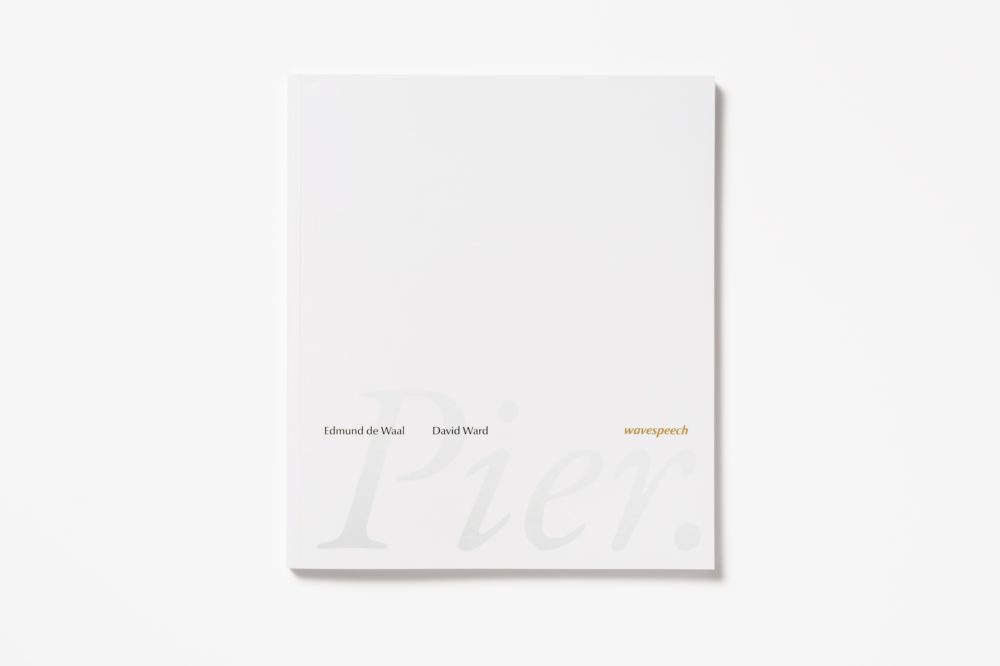
wavespeech is an artist-signed and numbered publication in a limited edition of 200 that celebrates the collaboration between between Edmund de Waal and David Ward at the Pier Arts Centre, Orkney.

CBS News correspondent Martha Teichner visits the studio and discusses de Waal's pots, writing and the netsuke in this short video piece.

To mark the 20th anniversary of the adoption of the Washington Principles, the German Lost Art Foundation is convening an international conference of specialists: 20 Years Washington Principles: Roadmap for the Future, at the Haus der Kulturen der Welt in Berlin.
To mark the 20th anniversary of the adoption of the Washington Principles, the German Lost Art Foundation is convening an international conference of specialists: 20 Years Washington Principles: Roadmap for the Future, at the Haus der Kulturen der Welt in Berlin.
As part of the programme, Edmund de Waal will be delivering a lecture entitled On the Eve of Departure: Objects, Families, Stories.
Photo: Ansgar Koreng / CC BY-SA 3.0 (DE), CC BY-SA 3.0 de, Terms of license

Edmund de Waal joins Ben Luke on The Art Newspaper's podcast to discuss the journey of his netsuke collection and the current state of nazi-loot restitution.

The collection of netsuke, which were at the heart of de Waal's memoir The Hare with Amber Eyes, has been placed on permanent loan to the Jewish Museum in Vienna. Speaking about the loan, de Waal stated 'The decision to place the netsuke on loan allows them to tell the story of migration, identity and exile to a new audience'.
The collection of netsuke, which were at the heart of de Waal's memoir The Hare with Amber Eyes, has been placed on permanent loan to the Jewish Museum in Vienna. Speaking about the loan, de Waal stated 'The decision to place the netsuke on loan allows them to tell the story of migration, identity and exile to a new audience'.
"In The Hare with Amber Eyes, I wrote of how objects can evoke histories through touch, and a stipulation of the loan is that a group will be available for handling by the many visitors to the Jewish Museum.” An exhibition based on the family collection, which will also tour internationally, is due to open in November 2019. Click the link below to read more in the Art Newspaper's article about this loan.

The RIAN Designmuseum in Falkenberg, Sweden, selected three works from Edmund de Waal's archive: – and gone –, 2015; minerva, 2016 (pictured); and landscape with a calm, 2011; for their exhibition Samla, sortera, ta hand om. The exhibition explored the ideas of collecting, of private and public, and of the future of the museum's activities.

white island, II (for W.B.), (2018), was gifted to the Museo de Arte Contemporáneo de Ibiza for their permanent collection, following de Waal's solo exhibition in 2018.

Edmund de Waal will be in conversation with author of the critically-acclaimed book East West Street, Phillipe Sands at the Well Walk Pottery in Hampstead, north London.

This summer, MACE is holding de Waal's first exhibition in Spain. 'This is the white island', says de Waal: 'the white of the salt flats, the foam breaking in the breeze. The white of the rock. The white haze.' A place of transition and exchange, the artist has worked closely with the museum to create a special exhibition of recent white works - 'sculptures made for strong light' - alongside new installations, combining Paros marble, alabaster and Ibizan salt with his porcelain for the first time.
This summer, MACE is holding de Waal's first exhibition in Spain. 'This is the white island', says de Waal: 'the white of the salt flats, the foam breaking in the breeze. The white of the rock. The white haze.' A place of transition and exchange, the artist has worked closely with the museum to create a special exhibition of recent white works - 'sculptures made for strong light' - alongside new installations, combining Paros marble, alabaster and Ibizan salt with his porcelain for the first time.
Photo: Ferran Nogues, CC BY-SA 2.0, License details

The Rosenheimer Collection of de Waal’s early vessels is on display at the New Art Centre, Wiltshire, from 9th June. The exhibition focuses on de Waal's early work and celebrates his twenty-five year relationship with friend and collector, Joram Rosenheimer.

Tracing its journey from 18th century China to Europe, de Waal shares the rich and fascinating history of porcelain and explores his own decades-long relationship with the decorative arts at Cheltenham Literary Festival. Chaired by Rosie Goldsmith.

This year's chair of the Wellcome Book Prize judging panel, de Waal gave their annual lecture at the Hay Literary Festival, speaking about mortality and how it is reflected across different genres and art-forms. Titled Memory and Memorial: Writing About the End of Life, de Waal discussed the poetry of Anne Carson and Max Porter, the memoirs of Paul Kalanithi and Marion Coutts, and the writings of Atul Gawande and Julia Samuel. He also spoke about his own works and collaborations exploring themes and ideas of memorial.

For the Royal Ballet's 2017/18 Season, de Waal designed the set for a new piece by their resident choreographer, Wayne McGregor. Set to Leonard Bernstein's Chichester Psalms (1965), Yugen was commissioned to celebrate the centenary of Bernstein's birth. For these 'heart breaking songs of exile', the artist created 'places of refuge and pause', and costumes in a spectrum of reds with designer, Shirin Guild. Click below to read de Waal's text on the collaboration for The Daily Telegraph and here to watch a video of McGregor rehearsing with The Royal Ballet dancers.
For the Royal Ballet's 2017/18 Season, de Waal designed the set for a new piece by their resident choreographer, Wayne McGregor. Set to Leonard Bernstein's Chichester Psalms (1965), Yugen was commissioned to celebrate the centenary of Bernstein's birth. For these 'heart breaking songs of exile', the artist created 'places of refuge and pause', and costumes in a spectrum of reds with designer, Shirin Guild. Click below to read de Waal's text on the collaboration for The Daily Telegraph and here to watch a video of McGregor rehearsing with The Royal Ballet dancers.
Photo © ROH, 2018. Photographed by Andrej Uspenski.

Vale is the first medal made by the artist, commissioned especially by the British Art Medal Society. Discussing this 'wonderfully provocative' invitation, de Waal describes how he 'kept coming back to the image of the obol, the silver coin given to Charon as payment for that great transition at death across the river Styx... So I created a silver coin.
Vale is the first medal made by the artist, commissioned especially by the British Art Medal Society. Discussing this 'wonderfully provocative' invitation, de Waal describes how he 'kept coming back to the image of the obol, the silver coin given to Charon as payment for that great transition at death across the river Styx... So I created a silver coin.
On the one side is an image taken from an early Greek lekythos of the prow of Charon’s boat with the single word vale, farewell. On the reverse are the words, “this is Charon’s obol. A kind of viaticum – what fierce brightness.” I made the model in porcelain and have worked the clay to give a feeling of something worn away and abraded.'
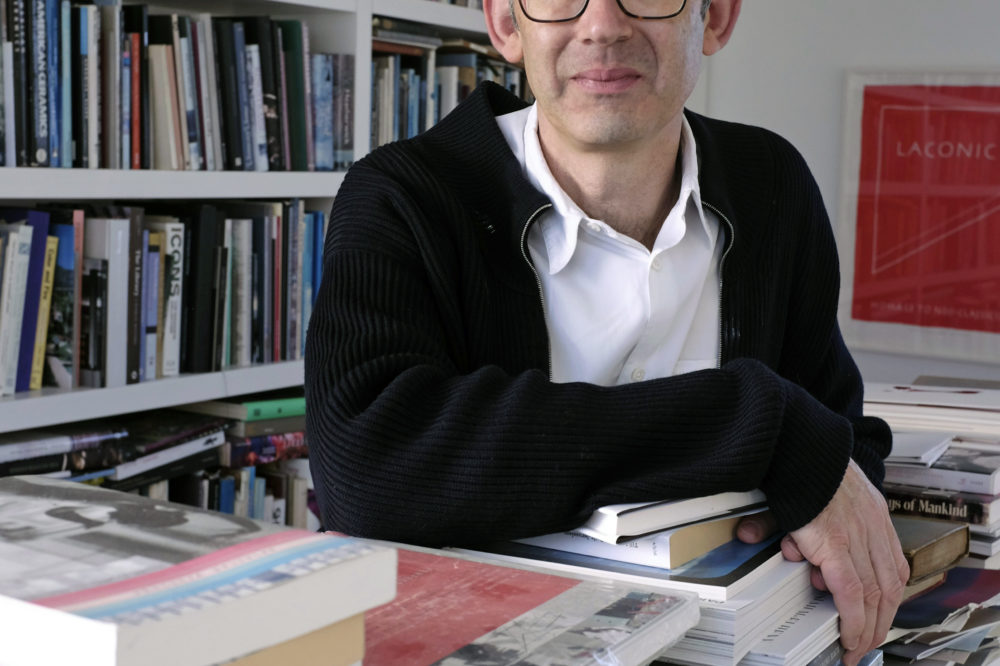
Irish author Mark O’Connell been awarded the 2018 Wellcome Book Prize for his extraordinary debut To Be a Machine: Adventures among cyborgs, utopians, hackers and the futurists solving the modest problem of death. The prize judging panel of five people was this year chaired by Edmund de Waal, and includes neuroscientist Hannah Critchlow, journalists Bryony Gordon and Sumit Paul-Choudhury, and writer Sophie Ratcliffe. De Waal described the book as "a passionate, entertaining and cogent examination of those who would choose to live forever".
Irish author Mark O’Connell been awarded the 2018 Wellcome Book Prize for his extraordinary debut To Be a Machine: Adventures among cyborgs, utopians, hackers and the futurists solving the modest problem of death. The prize judging panel of five people was this year chaired by Edmund de Waal, and includes neuroscientist Hannah Critchlow, journalists Bryony Gordon and Sumit Paul-Choudhury, and writer Sophie Ratcliffe. De Waal described the book as "a passionate, entertaining and cogent examination of those who would choose to live forever".
Photo: Eamon McCabe

This large-scale vitrine work, a place made fast (2014), is on loan to Things of Beauty Growing: British Studio Pottery - an exhibition first staged at the Yale Center for British Art and soon to open at the Fitzwilliam Museum, Cambridge, in March. The exhibition tells the story of studio pottery in Britain from the early twentieth century to the present, focusing on the evolution of the vessel form.

A recent pair of black works has been selected for Actions. The image of the world can be different, the inaugural exhibition at the newly-refurbished Kettle's Yard. The exhibition seeks to reassert the potential of art as a poetic, social and political force in the world. Below is a link de Waal's Telegraph article on his correspondence with Jim Ede and why you must visit the new Kettle's Yard, one of his favourite places in the world. Click the link below, to read de Waal's piece in The Daily Telegraph about the show.
A recent pair of black works has been selected for Actions. The image of the world can be different, the inaugural exhibition at the newly-refurbished Kettle's Yard. The exhibition seeks to reassert the potential of art as a poetic, social and political force in the world. Below is a link de Waal's Telegraph article on his correspondence with Jim Ede and why you must visit the new Kettle's Yard, one of his favourite places in the world. Click the link below, to read de Waal's piece in The Daily Telegraph about the show.
Photo: © Andrew Dunn

Three new beautiful titles featuring de Waal's work have recently been published. Things of Beauty Growing is the catalogue for the exhibition of the same name which opened at the Yale Center for British Art in Connecticut last year, and which is soon to come to the UK at the Fitzwilliam Museum in Cambridge.
Three new beautiful titles featuring de Waal's work have recently been published. Things of Beauty Growing is the catalogue for the exhibition of the same name which opened at the Yale Center for British Art in Connecticut last year, and which is soon to come to the UK at the Fitzwilliam Museum in Cambridge.
Vitamin C: Clay + Ceramic is a survey of ceramic artists which includes work from de Waal's exhibition Irrkunst at Galerie Max Heltzer last year, and The Artist Project accompanies the Metropolitan Museum's award-winning series of thought-provoking interviews and in which de Waal highlights a Tibetan Monk's Cap ewer, from the Met's collection.

The Archive of the Eprhussi family, as explored by the author in The Hare with Amber Eyes, has been donated to the Jewish Museum in Vienna. In his own words, "On 31st January, we formally handed over our family archive to the Jewish Museum in Vienna.
The Archive of the Eprhussi family, as explored by the author in The Hare with Amber Eyes, has been donated to the Jewish Museum in Vienna. In his own words, "On 31st January, we formally handed over our family archive to the Jewish Museum in Vienna.
The Ephrussi Archive contains hundreds of photographs, notebooks, diaries and letters relating to the family’s life in Vienna, Paris, Odessa and Tokyo. It also includes manuscripts of Elisabeth de Waal’s novels and a Secessionist album of watercolours of characters in Fin-de-Siecle Vienna. In the autumn, the netsuke collection will be joining the museum on long-term loan also. We are so grateful for the warmth of the reception given to my father, Victor, by the Director and curators of the Museum." Image © wulz.cc

In honour of the late Martin Roth, de Waal was invited to give the inaugural lecture set up in his friend's memory. De Waal's talk, I walk the line: Art on the border, was delivered in January at the Albertinum in Dresden. Click below to listen to a recording of the lecture.
In honour of the late Martin Roth, de Waal was invited to give the inaugural lecture set up in his friend's memory. De Waal's talk, I walk the line: Art on the border, was delivered in January at the Albertinum in Dresden. Click below to listen to a recording of the lecture.
Photo: © Jorg Blobelt. CC BY-SA 4.0, License terms

Edmund de Waal is thrilled to be a part of Frederick Wiseman's extraordinary new film about the New York Public Library.
Edmund de Waal is thrilled to be a part of Frederick Wiseman's extraordinary new film about the New York Public Library.
Photo: Elisa Rolle, CC BY-SA 3.0, License terms

Last autumn, the Academy of Arts in Berlin presented an exhibition examining the relationship between the critic Walter Benjamin (1892–1940) and the writer Bertolt Brecht (1898–1956). The exhibition included a number of contemporary artworks, including de Waal's casualty list from 2017 (see above).
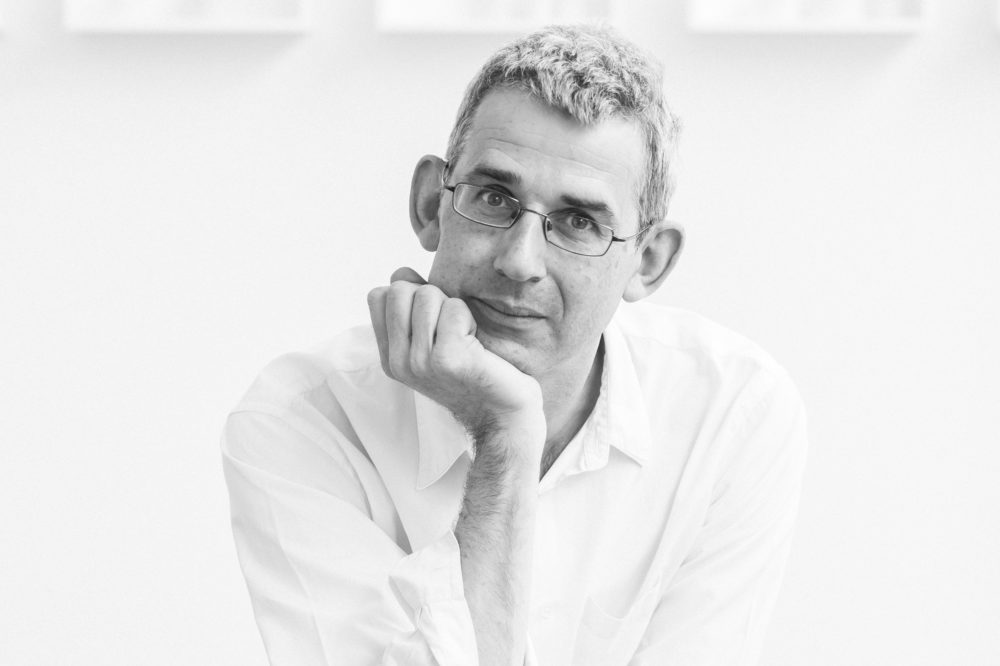
Edmund de Waal, James Ivory and Hilary Mantel are among the first participants in Frick Diptychs, a new series of small books to be published by the museum that pair masterworks from the Frick Collection with critical and literary essays. De Waal's essay will be on the subject of a pair of porcelain and bronze candlesticks by the 18th-century French metalworker Pierre Gouthière.

A major exhibition of work by Edmund de Waal and Giorgio Morandi was on display this summer at Artipelag in Stockholm. Exploring the visual and literary dialogue between the two artists, the exhibition featured over fifty paintings by Morandi, some of which had never before left Bologna, and over thirty works by de Waal. The exhibition included some of de Waal’s largest sculptures to date alongside a new body of work made especially for the light-filled galleries of Artipelag and in dialogue with Morandi’s paintings.
A major exhibition of work by Edmund de Waal and Giorgio Morandi was on display this summer at Artipelag in Stockholm. Exploring the visual and literary dialogue between the two artists, the exhibition featured over fifty paintings by Morandi, some of which had never before left Bologna, and over thirty works by de Waal. The exhibition included some of de Waal’s largest sculptures to date alongside a new body of work made especially for the light-filled galleries of Artipelag and in dialogue with Morandi’s paintings.
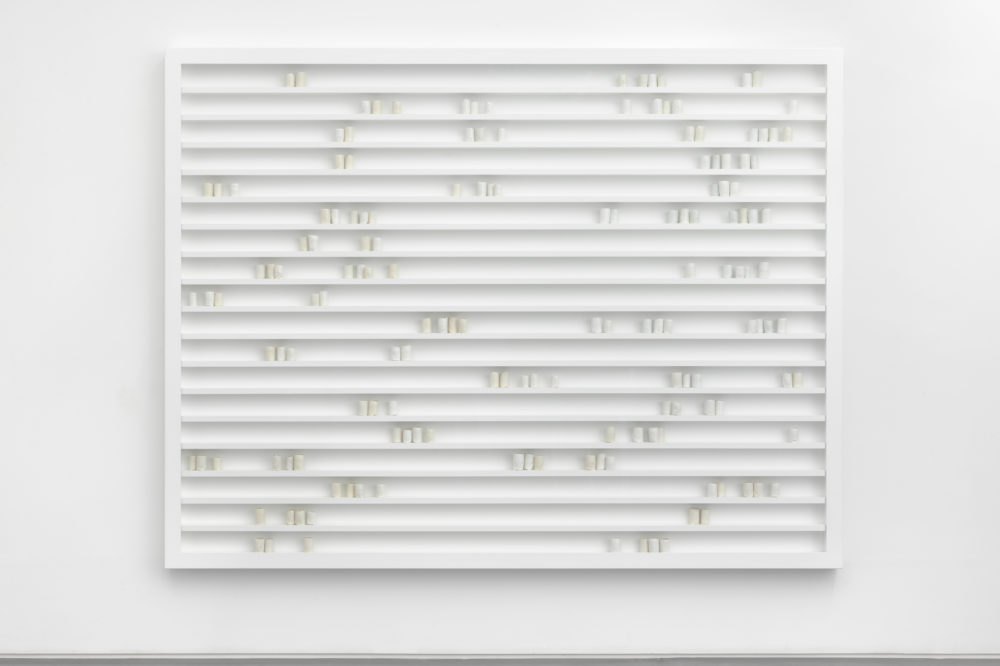
This large-scale vitrine work, a place made fast (2014), is now on view at the Yale Centre for British Art as part of Things of Beauty Growing: British Studio Pottery until 3rd Dec. The exhibition tells the story of studio pottery in Britain, from the early twentieth century to the present, by focusing on the evolution of the vessel form. The show will travel to the Fitzwilliam Museum in Cambridge for March 2018.

Edmund de Waal joins forces with Ai Weiwei in a collaborative group show examining the history of ceramics, juxtaposing their own works with ancient Chinese pottery and modernist works by the likes of Picasso, Mirò and Fontana. Alongside works from de Waal's archive, the exhibition includes de Waal's large-scale installation, Irrkunst, shown earlier this year in Berlin.

In his first talk for the Leo Baeck Institute, entitled 'On the eve of departure: Art and Exile', Edmund de Waal will talk about the telling of family stories through words and sculpture, touching on his writing of The Hare with Amber Eyes and works by Paul Celan and Walter Benjamin.
In his first talk for the Leo Baeck Institute, entitled 'On the eve of departure: Art and Exile', Edmund de Waal will talk about the telling of family stories through words and sculpture, touching on his writing of The Hare with Amber Eyes and works by Paul Celan and Walter Benjamin.
Photo: Ben McKee

As part of the 12th East Wing Biennial exhibition at the Courtauld Institute of Art, Edmund de Waal has loaned a small pair of vitrines called in Berggasse to sit above a pair of doors in the main entrance to the building. The exhibition also features work by Anthony Gormley, Rachel Whiteread, Jim Lambie and Tracey Emin.
As part of the 12th East Wing Biennial exhibition at the Courtauld Institute of Art, Edmund de Waal has loaned a small pair of vitrines called in Berggasse to sit above a pair of doors in the main entrance to the building. The exhibition also features work by Anthony Gormley, Rachel Whiteread, Jim Lambie and Tracey Emin.
Photo: Steve Daniels, CC BY-SA 2.0, License terms

The Jewish Museum in London are showing two works of Edmund de Waal's in their exhibition on Jewish ceramicists. Both early pieces from the Crafts Council's permanent collection, the works will be shown alongside vessels by Lucie Rie, Hans Coper and Grete Marks. De Waal has also contributed an essay to their exhibition catalogue, which will be published later this year.

Edmund de Waal has written an exhibition catalogue essay for a major retrospective on Cy Twombly, being held at the Centre Pompidou in Paris. De Waal writes, 'This finding a whiteness runs through Twombly's life as an artist, a photographer, a maker of sculpture, a reader of poetry...' The catalogue will be available to purchase both at the museum and online.
Edmund de Waal has written an exhibition catalogue essay for a major retrospective on Cy Twombly, being held at the Centre Pompidou in Paris. De Waal writes, 'This finding a whiteness runs through Twombly's life as an artist, a photographer, a maker of sculpture, a reader of poetry...' The catalogue will be available to purchase both at the museum and online.
Photography: Ben McKee

Edmund de Waal and Ai Weiwei's collaborative exhibition examining the history of ceramics which first opened in September 2016 at the Universalmuseum Joanneum, Graz, has now travelled to Prague. The exhibition juxtaposes their own works with significant examples from Chinese pots to the modernist works of Picasso, Mirò and Fontana.
Edmund de Waal and Ai Weiwei's collaborative exhibition examining the history of ceramics which first opened in September 2016 at the Universalmuseum Joanneum, Graz, has now travelled to Prague. The exhibition juxtaposes their own works with significant examples from Chinese pots to the modernist works of Picasso, Mirò and Fontana.
Photography: National Gallery of Prague

Letters from Tomis, I, an installation from 2015, has been gifted to the collection of Middlebury College Museum of Art in Vermont where it is now on view.
Letters from Tomis, I, an installation from 2015, has been gifted to the collection of Middlebury College Museum of Art in Vermont where it is now on view.
Photography: Ian Skelton

Lettres de Londres was Edmund de Waal's first exhibition in Geneva and featured over 25 works made between 2013 and 2016. The works directly respond to the writings of the French philosopher Voltaire, who lived and worked in the city towards the end of his life. His 1734 collection of essays - Letters to London - was the inspiration behind this exhibition.

As part of the Aldeburgh Festival, Edmund de Waal's piece shadow stones was included in the exhibition Orchestra of Letters at the Lettering Arts Centre.
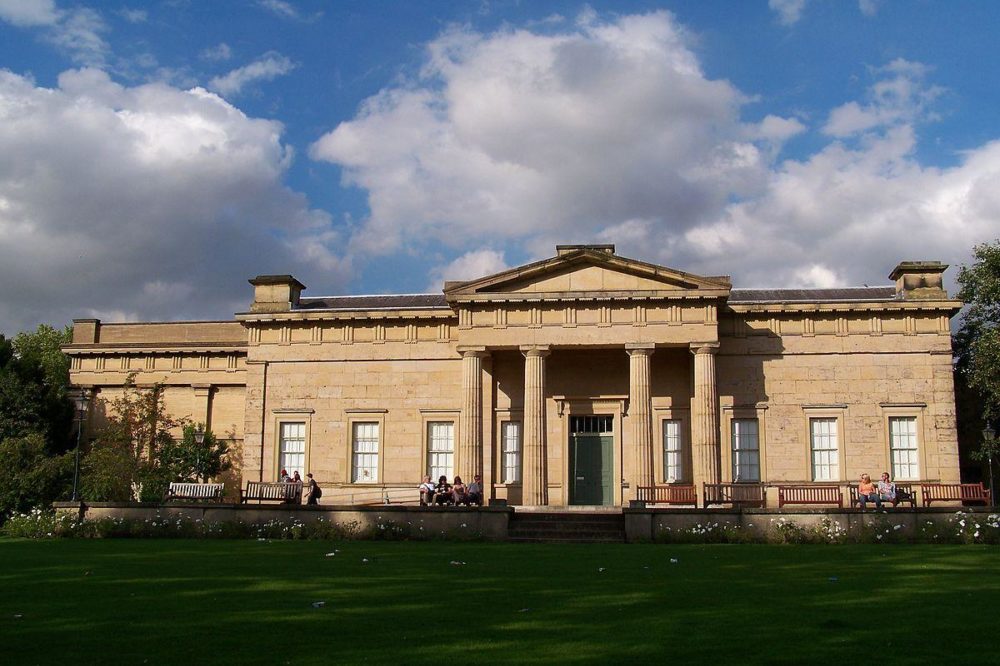
For this annual lecture for the Centre of Ceramic Art as part of York University and York Art Gallery, Edmund de Waal will explore a history of obsession with porcelain and will discuss his recent projects in Vienna, Stockholm and Los Angeles.
For this annual lecture for the Centre of Ceramic Art as part of York University and York Art Gallery, Edmund de Waal will explore a history of obsession with porcelain and will discuss his recent projects in Vienna, Stockholm and Los Angeles.
Photography: Kaly99 Licence details

The Art Gallery of Western Australia has acquired a new ground, II (2015) for their permanent collection. The work was first shown in 2016 at the Gagosian Gallery in Beverley Hills and is the first of de Waal's to be on public display in the country.

Edmund de Waal has gifted a new work called fetched home (2016) to the University of Sheffield, which has gone on display at the Western Bank Library. The piece was unveiled alongside a talk by de Waal on 'Homelessness, Exile and Art', in which he discussed the influence of Paul Celan's poetry on his work, the process of making as a way of finding a home for his vessels, and how writing and art can overcome the sense of not belonging in the world.

The Government Art Collection have acquired Edmund de Waal's work, a short history of the China trade (2016), for the British Ambassador’s Residence in Beijing.

This winter Edmund de Waal's curated exhibition, During the Night, will open at the Kunsthistorisches Museum in Vienna. The show is the culmination of three years spent choosing particular historical objects, paintings and treasures from the museum's collections, from 16th-century corals, dragon-shaped vessels and Roman fibulae to works by Joachim Patinir, Cranach and Roelant Savery.
This winter Edmund de Waal's curated exhibition, During the Night, will open at the Kunsthistorisches Museum in Vienna. The show is the culmination of three years spent choosing particular historical objects, paintings and treasures from the museum's collections, from 16th-century corals, dragon-shaped vessels and Roman fibulae to works by Joachim Patinir, Cranach and Roelant Savery.
Inspired by an encounter with a drawing of a nightmare by Albrecht Dürer, the exhibition will explore themes of anxiety, the fear of the unknown and what terrors can be found after dark. During the Night is the second exhibition in a series of personally curated projects at the Kunsthistorisches Museum, initiated by Ed Ruscha's, The Ancients Stole all Our Great Ideas, in 2012.
Photography: Photography © KHM-Museumsverband

A series of early works by Edmund de Waal are currently on view at the Gardiner Museum in Toronto. The works are taken from two Canadian private collections and include cargo, vessels made by de Waal in 1990s and inspired by the history of cargos bringing porcelain from China and Japan to Europe, and twin, two lidded jars commissioned by one of the collectors to celebrate the birth of twins in the family.
A series of early works by Edmund de Waal are currently on view at the Gardiner Museum in Toronto. The works are taken from two Canadian private collections and include cargo, vessels made by de Waal in 1990s and inspired by the history of cargos bringing porcelain from China and Japan to Europe, and twin, two lidded jars commissioned by one of the collectors to celebrate the birth of twins in the family.
Photography: remundo Licence details

Edmund de Waal's work the fascination of what's difficult is currently on view at Manchester Art Gallery, as part of their exhibition Modern Japanese Design. De Waal's installation, first displayed in 2012 at Waddesdon Manor, is shown alongside pieces from the museum's collections of fashion, furniture, lighting, glass, metalwork and ceramics, in an exploration of how materials and techniques have influenced Japanese design.

Edmund de Waal introduces During the Night, discussing some of the objects and paintings in the show as well as the inspiration behind the exhibition.
Edmund de Waal introduces During the Night, discussing some of the objects and paintings in the show as well as the inspiration behind the exhibition.
Photography: Photography © KHM-Museumsverband

The Hare with Amber Eyes has been named as the book of the decade by independent booksellers and their readers. The 'Best of the Best' campaign was launched earlier this year to coincide with the 10th anniversary of Independent Bookshop Week. Other authors on the shortlist included Hilary Mantel, Anne Enright, Kate Atkinson and Jeanette Winterson. On receiving the award, Edmund de Waal said 'To be amongst this gathering of writers is a huge honour and to win this prize is overwhelming.'

Following on from a major collaboration in 2015, Edmund de Waal joins forces with Aurora Orchestra again, this time to explore the backdrop to Richard Strauss' work Metamorphosen. De Waal will take the audience on a tour around the ruins of German cities at the end of World War II before a live performance with guest conductor Andrew Marwood.
Following on from a major collaboration in 2015, Edmund de Waal joins forces with Aurora Orchestra again, this time to explore the backdrop to Richard Strauss' work Metamorphosen. De Waal will take the audience on a tour around the ruins of German cities at the end of World War II before a live performance with guest conductor Andrew Marwood.
Photography: By Ungry Young Man from Vienna, Austria Licence details
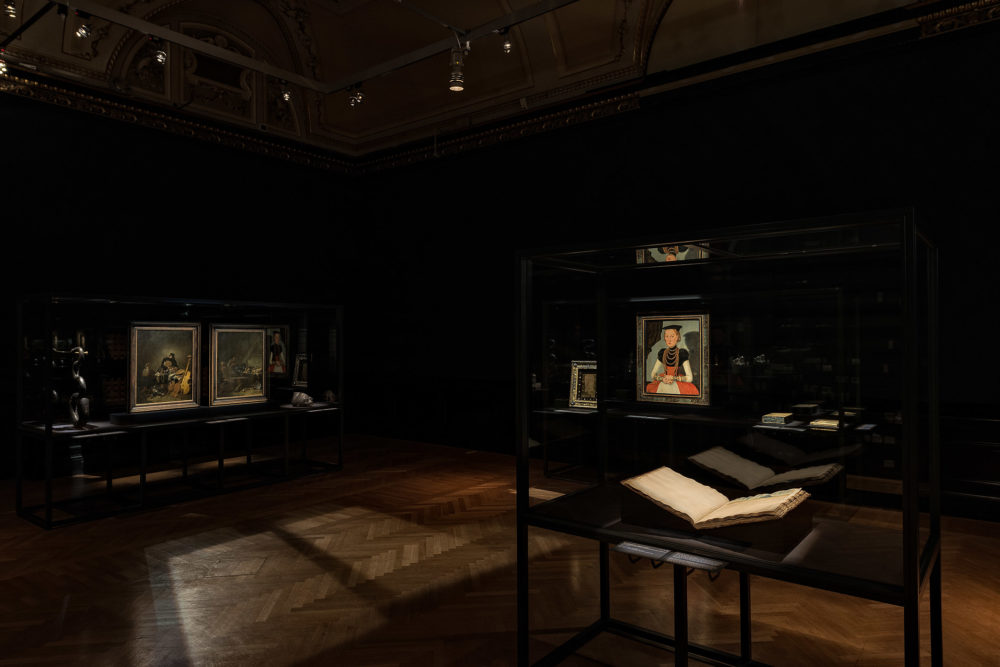
To celebrate the opening of Edmund de Waal's exhibition, During the Night, the Kunsthistorisches Museum will be opening their doors for an all night programme of tours, talks, live music and readings. Join de Waal at 2.00am in the galleries to hear some of the stories and secrets behind particular objects in the exhibition.
To celebrate the opening of Edmund de Waal's exhibition, During the Night, the Kunsthistorisches Museum will be opening their doors for an all night programme of tours, talks, live music and readings. Join de Waal at 2.00am in the galleries to hear some of the stories and secrets behind particular objects in the exhibition.
Photography: Photography © KHM-Museumsverband
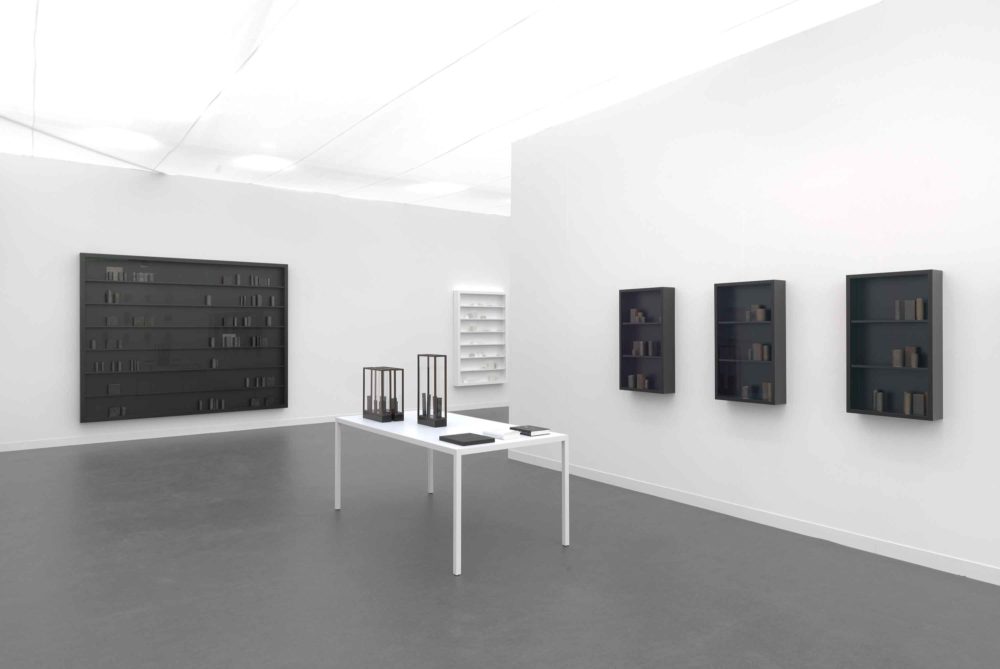
Edmund de Waal discusses the body of work he made for Gagosian Gallery's stand at Frieze Art Fair, where his porcelain was shown alongside new materials including graphite, silver and alabaster.

Edmund de Waal will be travelling to Ireland this Autumn to give a talk about the Fonthill Vase, a 14th century vessel and one of the earliest pieces of porcelain to arrive in Europe from China, which has been in the permanent collection of the National Museum of Ireland in the 1950s. The talk comes out of de Waal's research for his book, The White Road, in which he describes first visiting the museum on a pilgrimage to see the vase.
Edmund de Waal will be travelling to Ireland this Autumn to give a talk about the Fonthill Vase, a 14th century vessel and one of the earliest pieces of porcelain to arrive in Europe from China, which has been in the permanent collection of the National Museum of Ireland in the 1950s. The talk comes out of de Waal's research for his book, The White Road, in which he describes first visiting the museum on a pilgrimage to see the vase.
Photography: GualdimG Licence details

Edmund de Waal has been invited to give the annual Pilkington Lecture for the Friends of Whitworth Gallery in Manchester. His talk, entitled Give it shadow enough: Art and memory, will explore the intersections between the visual arts, poetry and memory making and draw on his own practice as a maker and that of other 20th century artists. The talk will be followed by supper in the galleries.
Edmund de Waal has been invited to give the annual Pilkington Lecture for the Friends of Whitworth Gallery in Manchester. His talk, entitled Give it shadow enough: Art and memory, will explore the intersections between the visual arts, poetry and memory making and draw on his own practice as a maker and that of other 20th century artists. The talk will be followed by supper in the galleries.
Photography: Citysuitesimages Licence details

Edmund de Waal joins this year's Erasmus Prize winner, AS Byatt, to talk about her life and writing.
Edmund de Waal joins this year's Erasmus Prize winner, AS Byatt, to talk about her life and writing.
Photography: C messier Licence details

This November Edmund de Waal has been invited to give the keynote lecture for the Israel Museum's annual International Symposium on Collecting and Provenance. He will talk about the writing of The Hare with Amber Eyes, restitution and the history of lost collections.
This November Edmund de Waal has been invited to give the keynote lecture for the Israel Museum's annual International Symposium on Collecting and Provenance. He will talk about the writing of The Hare with Amber Eyes, restitution and the history of lost collections.
Photography: צילום:ד"ר אבישי טייכר, Licence details

Edmund de Waal will be in New York in November to be honoured at The Frick Collection Autumn Dinner. This annual event celebrates individuals who have contributed to arts and culture throughout the last year.
Edmund de Waal will be in New York in November to be honoured at The Frick Collection Autumn Dinner. This annual event celebrates individuals who have contributed to arts and culture throughout the last year.
Photography: Ajay Suresh Licence details

In his first solo exhibition for Gagosian gallery in London, Edmund de Waal showed ten new works at Frieze Art Fair. For this body of work, de Waal draws on memories and recollections in a series of elegies to the people and places most important him - his great-grandfather, the poet Paul Celan, Odessa, Czernowitz and Paris. And alongside porcelain vessels, de Waal introduced new materials to his vitrines, including graphite, silver and alabaster.
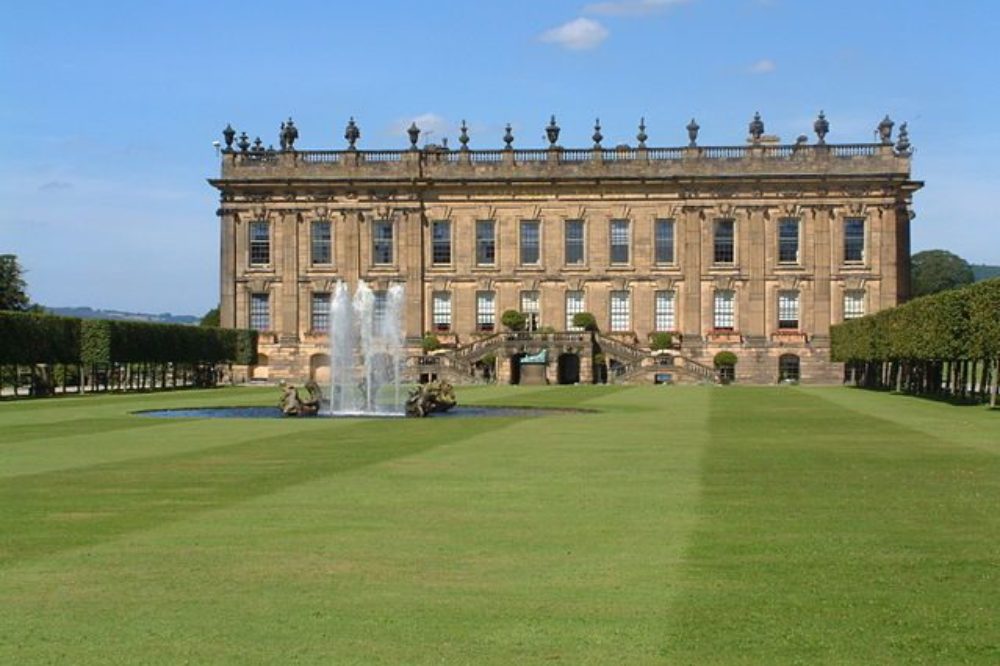
Edmund de Waal will be talking at The Chatsworth Festival, Art Out Loud, a festival of talks by artists, curators and writers.
Edmund de Waal will be talking at The Chatsworth Festival, Art Out Loud, a festival of talks by artists, curators and writers.
Photography: Rob Bendall Licence details

Curated by David Ward, this exhibition at Turner Contemporary, Margate, explores the ways in which artists have used this universal and recurring form, and the very idea of ‘roundness’.

Edmund de Waal’s piece and speech is currently on loan to the Geffrye Museum, London.
Edmund de Waal’s piece and speech is currently on loan to the Geffrye Museum, London.
Photography: Heather Cowper Licence details

Edmund de Waal’s first solo show in Berlin is now open across the two gallery spaces of Galerie Max Hetzler in Charlottenburg. Based on the writings of Walter Benjamin, the exhibition title has been taken from his concept of the art of getting lost, the art of noticing what has been disregarded.

To celebrate the 220th anniversary of the National Gallery in Prague, Edmund de Waal will be loaning sixty-three netsuke from his personal collection to this special exhibition exploring generosity within its historical, poetical and social context.

‘I do not want art for a few’: Crafting Democracy
‘I do not want art for a few’: Crafting Democracy
At the heart of the arts and crafts movement is democracy, a crossing of boundaries between work and life. This talk will reflect on how craft is interdisciplinary and how William Morris continues to influence making, writing and talking about craft today.

Edmund de Waal will be delivering a lecture at the Literatur Haus, Graz, celebrating the launch of the German edition of The White Road.

For the Foundling Museum’s summer show, curated by Cornelia Parker and on the theme of ‘found’, Edmund de Waal is lending a piece made last year called the lost and the found.

Walter Benjamin, Memory and Berlin
Walter Benjamin, Memory and Berlin
Edmund de Waal will be in conversation with Dr. Martin Roth, director of the V&A, at the Akademie der Künste, Berlin.
Photography: Jensens Licence details

Edmund de Waal will be talking with Mark Fisher at the Ledbury Poetry Festival about his Desert Island Poems: the poems that have mattered to him throughout his life.
Edmund de Waal will be talking with Mark Fisher at the Ledbury Poetry Festival about his Desert Island Poems: the poems that have mattered to him throughout his life.
Photography: Ben McKee

For his lecture On Homelessness Edmund de Waal talked about place and displacement in poetry and the visual arts, from the German emigre poet Paul Celan to his own work as an artist and writer.
For his lecture On Homelessness Edmund de Waal talked about place and displacement in poetry and the visual arts, from the German emigre poet Paul Celan to his own work as an artist and writer.
Photography: Ben McKee

At heart the heart of this exhibition with Gagosian, Beverly Hills, is a series of responses to the Schindler House, the revolutionary 1922 building by Viennese émigré architect, Rudolph Schindler, which was so influential on composer, theorist and writer, John Cage.
At heart the heart of this exhibition with Gagosian, Beverly Hills, is a series of responses to the Schindler House, the revolutionary 1922 building by Viennese émigré architect, Rudolph Schindler, which was so influential on composer, theorist and writer, John Cage.
Photography: Jeff Mclane, Courtesy Gagosian Gallery

Edmund de Waal has been awarded the prestigious Windham Campbell prize for non-fiction for his memoir The Hare with Amber Eyes.
Edmund de Waal has been awarded the prestigious Windham Campbell prize for non-fiction for his memoir The Hare with Amber Eyes.
Photography: Ed Park

This unique project at the RA Library and Print Room sees Edmund de Waal explore the colour white and the impact that white objects have on their surroundings, through an interweaving of words and books with sculpture, paintings and photographs.
This unique project at the RA Library and Print Room sees Edmund de Waal explore the colour white and the impact that white objects have on their surroundings, through an interweaving of words and books with sculpture, paintings and photographs.
Photography: Mike Bruce

To mark the launch of white at the Royal Academy and the publication of The White Road, Edmund de Waal has collaborated with Aurora Orchestra to create a programme of events across London this Autumn, exploring the colour white through music, poetry and the visual arts.
To mark the launch of white at the Royal Academy and the publication of The White Road, Edmund de Waal has collaborated with Aurora Orchestra to create a programme of events across London this Autumn, exploring the colour white through music, poetry and the visual arts.
Photography: Mike Bruce

Edmund de Waal delivered the 2015 British Art Lecture at Tate Britain, London.
Edmund de Waal delivered the 2015 British Art Lecture at Tate Britain, London.
Photography: Anthony O'Neil, Licence details

Phaidon has now published a monograph about Edmund de Waal's work and practice. The book is the most comprehensive survey of his career to date and features texts by Emma Crichton-Miller, AS Byatt, Colm Toibin and Peter Carey. To celebrate its publication, de Waal gave a talk at the Victoria and Albert Museum about how and why he started making ceramics, the influences of other makers on his work, and future projects he is working towards.
Phaidon has now published a monograph about Edmund de Waal's work and practice. The book is the most comprehensive survey of his career to date and features texts by Emma Crichton-Miller, AS Byatt, Colm Toibin and Peter Carey. To celebrate its publication, de Waal gave a talk at the Victoria and Albert Museum about how and why he started making ceramics, the influences of other makers on his work, and future projects he is working towards.
Photography: Edward Park

Following a year of filming with Alan Yentob, the Imagine documentary on Edmund de Waal's studio life and practice was broadcast on BBC One on 5th November. The film covers a remarkable year; from moving studios, travelling across Europe to research his next book, to sitting at his wheel and making thousands of vessels for his first major exhibition in the USA with Gagosian, New York.
Following a year of filming with Alan Yentob, the Imagine documentary on Edmund de Waal's studio life and practice was broadcast on BBC One on 5th November. The film covers a remarkable year; from moving studios, travelling across Europe to research his next book, to sitting at his wheel and making thousands of vessels for his first major exhibition in the USA with Gagosian, New York.
Photography: Ben McKee
